Do you love flowers and want to learn more about kinds of common flowers? You’re in the right place! On this page, you will find a comprehensive list of flower names starting with each letter of the alphabet. Simply jump to each specific flower using the table of content below.
- Start with A
- Start with B
- Start with C
- Calceolaria
- Calendula
- California Poppy
- Calla Lily
- Camellia
- Candytuft
- Canna Lily
- Cape Leadwort
- Cape Primrose
- Cardinal Flower
- Carnation
- Catharanthus
- Catmint
- Celosia
- Cerastium Tomentosum
- Chicory
- Chionodoxa
- Chrysanthemum
- Clarkia
- Clematis
- Clover
- Columbine
- Coneflower
- Coral Bells
- Coral Vine
- Coreopsis
- Cornflower
- Corydalis
- Cosmos
- Cotoneaster
- Crocosmia
- Crocus
- Crown Imperial
- Cuckoo Flower
- Cyclamen
- D
- E
- F
- G
- H
- I
- J
- K
- L
- M
- N
- O
- P
- R
- S
- T
- U
- V
- W
- X
- Y
- Z
Start with A
Abutilon

Abutilon is a shrub that blooms during the summer. This plant produces flowers that may be white to a purple blue color.
The blooms are saucer-shaped, and the stems have gray, hairy leaves. The shrub may grow to around 15 feet, and many hybrids have been developed that you can enjoy.
Acacia

Acacias are soft, yellow flowers that tend to be fluffy. These plants are delicate and tender, growing best in sheltered gardens away from the cold frosts of northern climates.
Also known as wattle, these tend to flower in early spring. They can get to be seven feet high if not properly pruned.
Aconite

Aconite is a poisonous plant that is beautiful, which brings many people to plant it in their gardens. The flowers tend to be blue-purple or yellow in color, and the plant is native to mountainous areas.
The scapes can grow tall, often getting to be at least three feet high, making them a great addition to the back of flower beds.
African Daisy

The African Daisy is a perennial with flowers that come in a variety of colors including red, gold, and blue.
They are characterized by generally having a darker center, and the leaves are silvery in color. These flowers are great in cut flower arrangements or in the garden or as a container plant.
Agapanthus

Agapanthus comes in a variety of colors and heights. These showy flowers are produced in colors such as blue and purple.
The flower for an extended period of time, and they make a good border plant or addition to your container garden. They like sunlight, and some species are actually evergreen.
Ageratum
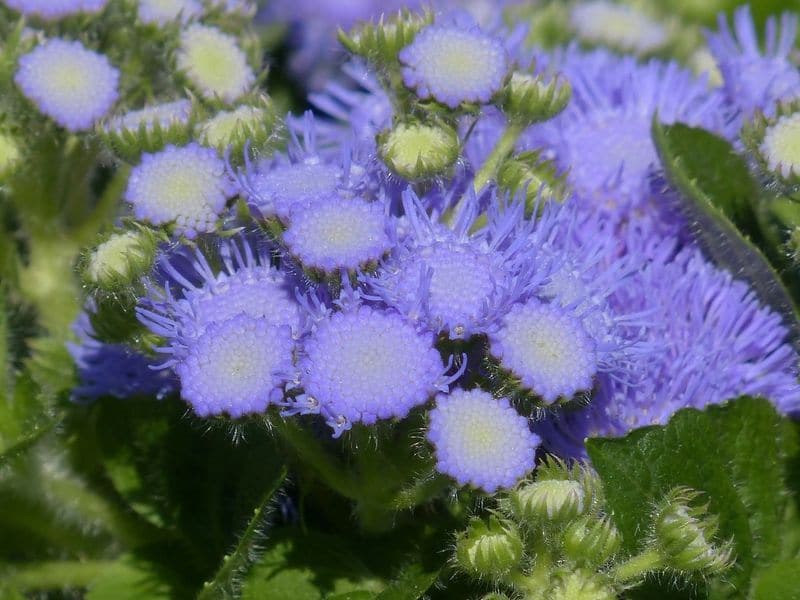
Ageratums are also known as the floss flower. These plants produce flowers that are fluffy and last for an extended period of time.
The flowers come in colors such as pink and bicolor. They come in dwarf and tall varieties, so you can pick the best size for your edging or bedding.
Alchemilla

Alchemilla is lady’s mantle, found throughout parts of America, Asia, and Europe. The plant’s flowers are yellow-green and last from early summer into fall.
This herb can be used in foods such as salads, and, as an herb, it has many purported uses, such as for wound healing and breastfeeding.
Allium

Allium is a family of plants that includes onions, chives, and garlic. Ornamental varieties produce rounded flowers in several colors, including rosy purple.
The flowers are long-lived even after being cut, so they make great additions to cut flower arrangements. They are typically planted in fall and bloom in spring and summer.
Alstroemeria

Alstroemeria is also called the Peruvian lily and is often grown commercially because the cut flowers last a long time.
It is a perennial, and the flower spikes that bloom are 12 to 24 inches high. They can be grown in pots and come in a range of colors, including cream, orange, and red, oftentimes with spots of other colors.
Alyssum

Alyssum or sweet alyssum is a hardy plant that features heat and drought resistance. Often grown as a component of alpine rock gardens, this plant can thrive in a wide range of regions across the United States, where it has become naturalized. Members of the mustard family, these plants smell sweet.
Amaranthus

Also known as Love Lies Bleeding, this plant has exotic looking foliage and tassels that are often blood-red in color. You can find plants with a range of leaf colors, from bronze to green. They are great as potted plants and can also be used in flower arrangements either cut or dried.
Amaryllis

The belladonna lily or Amaryllis, also known as the naked lady plant, is a South African plant that grows from a bulb. It produces blooms on purple-green stems that tend to grow over 24 inches tall.
The flowers are funnel-shaped and are pink or white. It flowers in fall, but the leaves provide decoration throughout winter and spring.
Anemone

The Anemone is also known as the Windflower. This plant is a perennial that spreads while growing.
It comes in a variety of colors, from white to purple, with some species not spreading quite as far while growing. The flowers last from summer through a portion of the autumn, making them a great addition to your garden.
Anise Hyssop
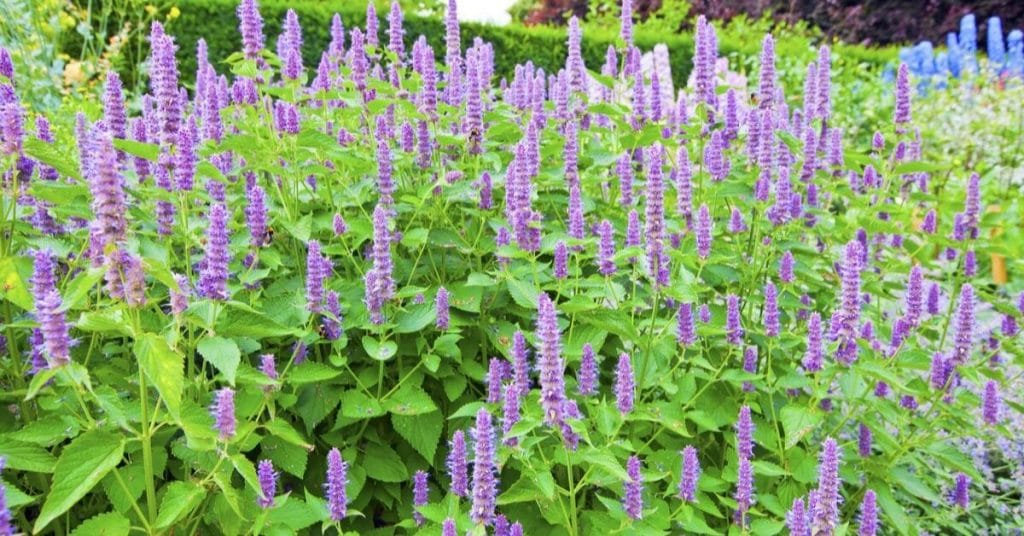
Anise Hyssop also goes by the name agastache and is an herb. The plant produces spikes of purple flowers that attract pollinators such as bees and butterflies.
The plant is native to North American and is not long lived, often needing to be propagated every year, or at a minimum of every three years.
Armeria Maritima

The Armeria maritima plant is also known as the sea thrift. It is an evergreen perennial that can be found in nature throughout northern Europe and the Mediterranean. The flowers are rounded and may be pink, white or red, depending on the species and cultivar, of which there are many.
Aster

The Aster or the Michaelmas Daisy is a hardy perennial that blooms between late summer and fall.
Numerous species exist, but the most commonly grown is the Aster novi-belgii, with blue, violet, pink, or white flowers, to mention a few colors it comes in. This plant is easy to grow and comes in a range of sizes.
Azalea

Azaleas belong to the family of rhododendrons and come in a wide range of colors. These flowers attract pollinators such as hummingbirds and come in a range of heights, from two to eight feet tall. These plants are long-lived and are one of the most hybridized plants in the entire world.
Start with B
Baby’s Breath

Gypsophila is also referred to as Baby’s Breath. These plants are hardy annuals that are commonly used in cut flower arrangements.
The flowers are most commonly white but also come in pink or rose colors. The plant comes in dwarf varieties as well as tall plants that get up to two feet tall and wide.
Bachelor’s Button

The plant known as the Bachelor’s Button also goes by other names such as cornflower and Centaurea. It is a hardy annual that most people find easy to grow.
The plant comes in colors from white to red, and by practicing dead heading the flowers, you can prolong the flowering period of this plant.
Balloon Flower
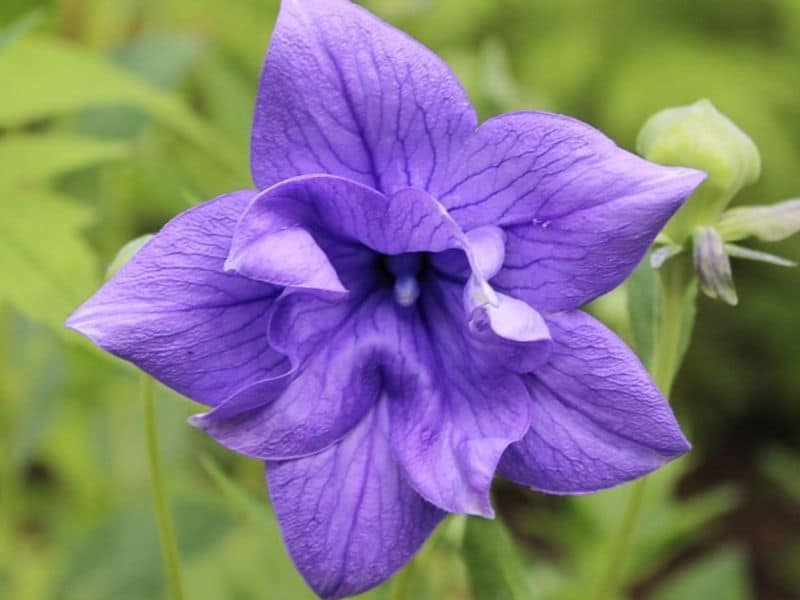
The Balloon Flower also goes by the name Platycodon or the Chinese bellflower. This plant is an herb and perennial with a short flowering period.
The flowers are typically a shade of blue or white or pale pink. These spread slowly and tend to be compact, so you’ll want to mark their position to avoid removing them as a weed.
Ballota

Ballota is a sub-shrub that is evergreen and forms mounds. It can grow and spread 1 to 2 feet in height and width.
The rounded leaves are covered in a silvery wool-like substance, and they produce small white flowers that have a pink tinge to them. The flower through spring and summer.
Bee Balm

Bee Balm is a bergamot plant that comes as a hardy perennial. Also known as wild bergamot, the species is Monarda didyma.
While the flowers don’t store well when picked, the leaves can be picked and processed for medicinal and culinary uses, such as adding it to summer drinks or making a tea from the leaves.
Begonia

The Begonia is a showy flower with fleshy leaves that are green or bronze in color. The flowers come in many colors, and they are considered half-hardy annuals.
They come in a variety of sizes, from small flowers with fibrous roots to trailing flowers that do well in hanging baskets.
Bellflower

The Bellflower or campanula is a group containing several hundred species of annuals and perennials. These plants tend to be easy to grow with either full sunlight or dappled shade.
They range in height from a few inches off of the ground to over 5 feet tall and needing to be staked. They flower from May through September.
Bergamot

Bergamot is a relatively of mint plants and has a rather pungent and citrus-like flavor. This plant can reach several feet tall and comes in perennial and annual varieties.
The flowers may be white, red, purple, or pink, and the plant tends to be semi-dormant during the winter months. It likes a sunny area although will tolerate partial shade.
Bergenia

Bergenia is also referred to as elephant’s ears. These plants are a great evergreen ground cover and have large, rounded leaves.
Some of the leaves, while green throughout much of the year, turn reddish in the fall. The plant has small pink flowers and is hardy but should be protected during freezing spells.
Billbergia

Billbergia is an easily grown bromeliad, and they are often grown as houseplants. The leaves are stiff and the foliage is spiny and sometimes mottled.
The flower spikes often droop, with pink or red bracts that have green or blue flower petals. The most common species is known as Queen’s Tears.
Black-eyed Susan

The Black-eyed Susan is a type of coneflower that also goes by the name Rudbeckia. These plants are similar to daisies but have bright yellow-orange flowers with a black center.
These plants range in height, with some flowers able to reach eight feet tall, while they spread to a mere three feet. Their flowers bloom from summer to early fall.
Blanket Flower
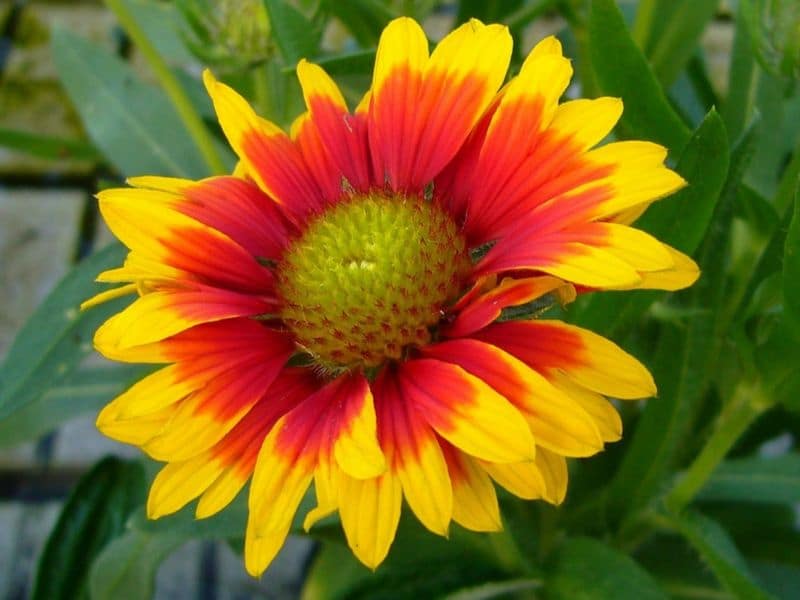
The Blanket Flower belongs to the Gaillardia family of flowers. These plants have a long blooming season, from summer until fall.
They attract pollinators such as butterflies and come in a range of colors including reds and oranges. The flowers may be solid colored or a combination of colors such as red and yellow.
Blazing Star

The Blazing Star plant is native to the American prairie. These plants add a splash of color with their lovely spikes that come in shades such as blue-purple.
The plant blooms from the top down the flower stalk, and it is a popular choice for cut flowers. It also attracts pollinators such as hummingbirds and butterflies.
Bleeding Heart
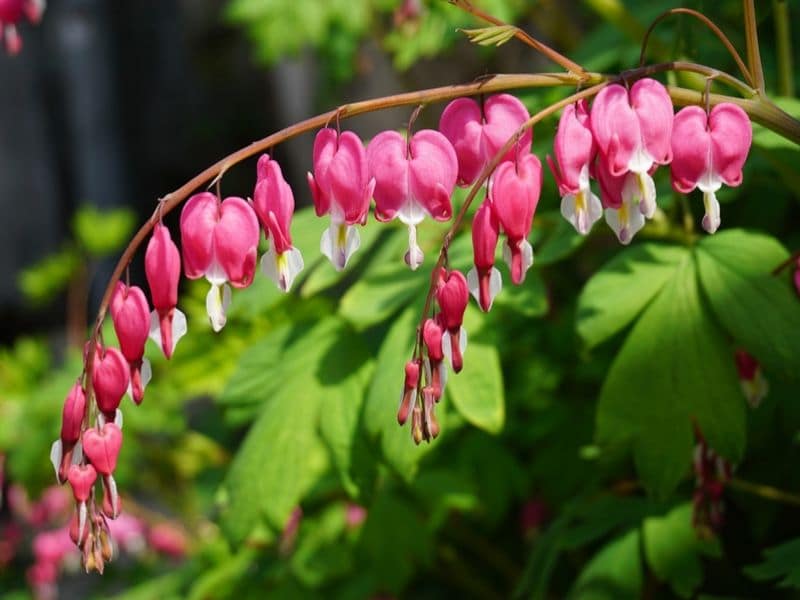
The Bleeding Heart or Dicentra spectabilis is a plant with fern-like foliage and a unique heart-shaped flower.
The flowers tend to be pink and white, although some are pure white, and they are classified as a perennial. This plant grows best in filtered sunlight rather than direct, and it should be sheltered from drying, hot winds.
Bletilla

Bletilla is also referred to as the Chinese ground orchid. It is part of a small group of orchids from China and Taiwan, and it is typically easy to cultivate, unlike some orchids.
The flowers have a bell shape and may be purple to magenta in color. The tip of the flower has a characteristic coloring of white and cerise. The plant can also be found in a white form.
Bluestar Flower
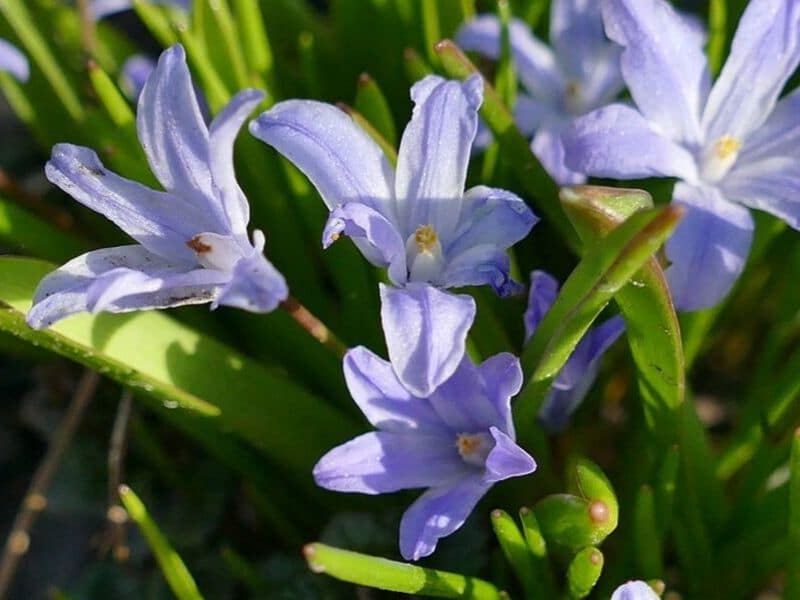
The Bluestar Flower is a perennial native to the United States. It produces dense clusters of pale blue flowers during the spring, and the foliage in the fall turns a golden color.
The leaves are lance-shaped and whorl up the stem, while the cluster of flowers is produced at the top of each stem.
Bluebonnets

Bluebonnets or Texas Bluebonnets, as many of them are, belong to the category of Lupins. These plants are annuals that produce a blue to purple flower.
The plants as well as the seeds are highly toxic. These plants tend to thrive in soils that are prone to droughts and disruptions, such as found in Texas Hill Country.
Blue-eyed Grass

The Blue-eyed Grasses belong to the genus Sisyrinchium. These plants have spires of yellow flowers that bloom during the summer.
The leaves are strap-shaped foliage, much like those seen with irises. Some plants in this genus have blue or white flowers. These plants need full sun to grow rather than shaded areas.
Borage

Borage is an annual or biennial and can grow several feet tall. The plant has star-shaped flowers with a characteristic appearance from their protruding black anthers.
They come in sky-blue, white, and pink colors, and the bush features fragile branches that break easily because they are hollow. The stems and leaves are covered in fine hairs.
Bottlebrush

The Bottlebrush flower or Callisetemon earned its name because the flower looks very similar to a bottle cleaning brush.
There are several species of this flower, with color choices such as creamy yellow flowers to a rich matte red. Some are lemon scented, and all can grow up to seven feet.
Bouvardia
The Bouvardia plants are a genus of plants that belong to the Rubiaceae family. There are close to 50 species of these plants, which are largely native to Mexico and Central America.
The genus was named in honor of the physician to Louis XIII, Charles Bouvard. These flowering plants make great additions to cut flower arrangements.
Brachyscome
Brachyscome is also known as the Swan River Daisy. These plants do well in beds, containers, and even hanging baskets.
The leaves tend to be delicate and feathery, while the flowers may be single colors or mixtures. The flowers tend to be faintly scented but are not suitable to use as cut flowers.
Brassica

Did you know that you can grow ornamental cabbages and kales? Belonging to the Brassica family, some of the edible varieties come in colorful patterns, such as having pink, rose, or white leaves. While they can be damaged by a harsh frost, these plants tend to be better in cooler temperatures.
Broom
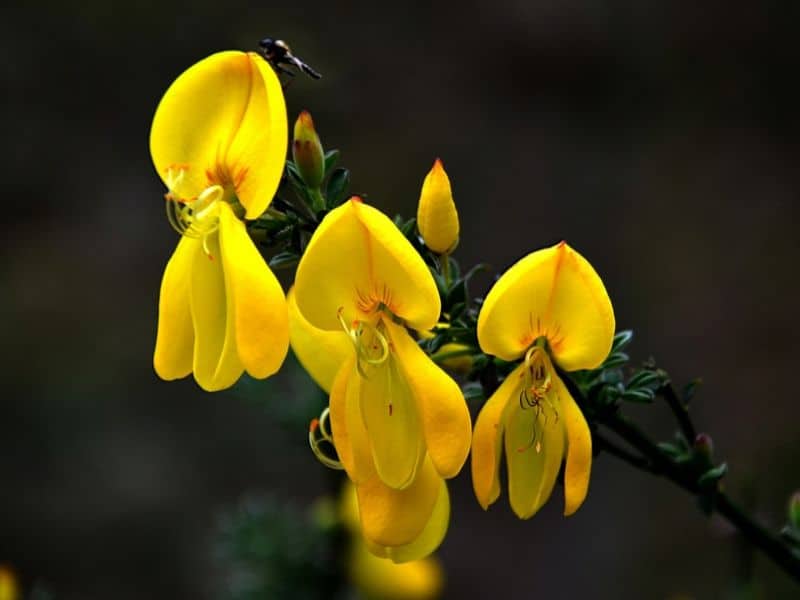
Broom or Cytisus is a deciduous plant that develops whippy stems. The flowers grow in thickly clustered bunches with yellow colored flowers that are fragrant and called “pea flowers”.
The scent is reminiscent of pineapple, and the plant can be grown to entwine with objects to make a focal point in your garden.
Buttercup

Buttercups belong to the genus Ranunculus. Some of these flowers are highly invasive, while other species are less so.
The genus has annuals and perennials, and many feature the characteristic yellow flower that we picture upon hearing “buttercups,” but some are cream or red in color. These are hardy plants that tolerate a range of conditions.
Butterfly Bush

There are three distinct species of butterfly bushes, with the most common as the deciduous Buddlejadavidii. This flowering plant features cone-shaped flowers in colors such as white or purple-red.
Other species have a waterfall of shoots with purple flowers or feature small clusters of orange balls on the evergreen plant. They typically need full sun.
Start with C
Calceolaria
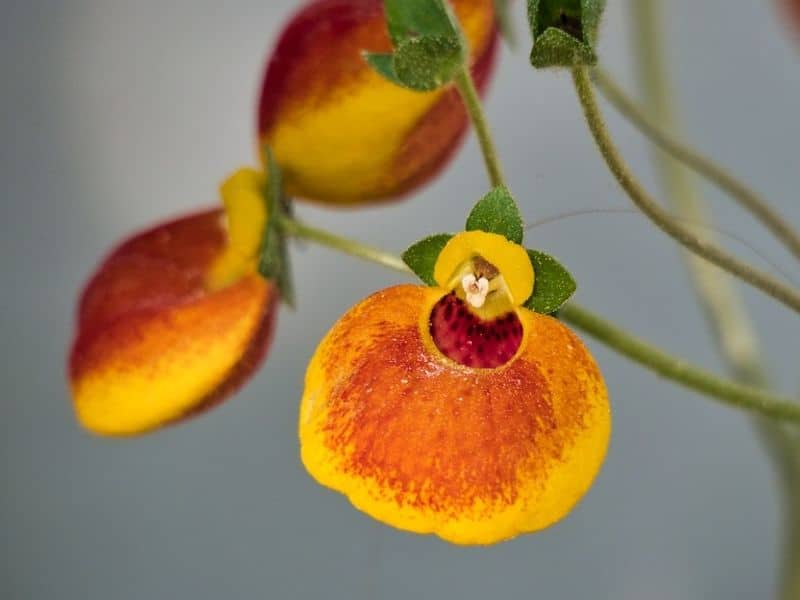
The Calceolaria or slipper flower is a plant best suited for indoor pots or containers. They can be grown from seed as an annual plant, with none of the plants extending past 16 inches in height and width.
The flowers bloom from early summer until the first frosts of the year. With careful cutting, these can make good cut flowers.
Calendula

The Calendula plant is also known as a pot marigold or English marigold. It tends to be fast growing and is a hardy plant but needs full sunlight.
The flowers are a range of yellows, oranges, and even greens. The plant can be easily grown by sowing seeds directly into the ground. Plants range from 12 to 28 inches in height.
California Poppy

The California Poppy or eschscholzia is a brightly colored flower with blue-green foliage. The flowers occur in yellow, cream, pink, and scarlet colors, and they’re usually 12 inches tall.
These plants are usually hardy and can even be found growing out of the cracks in paving slabs. They easily self-seed.
Calla Lily
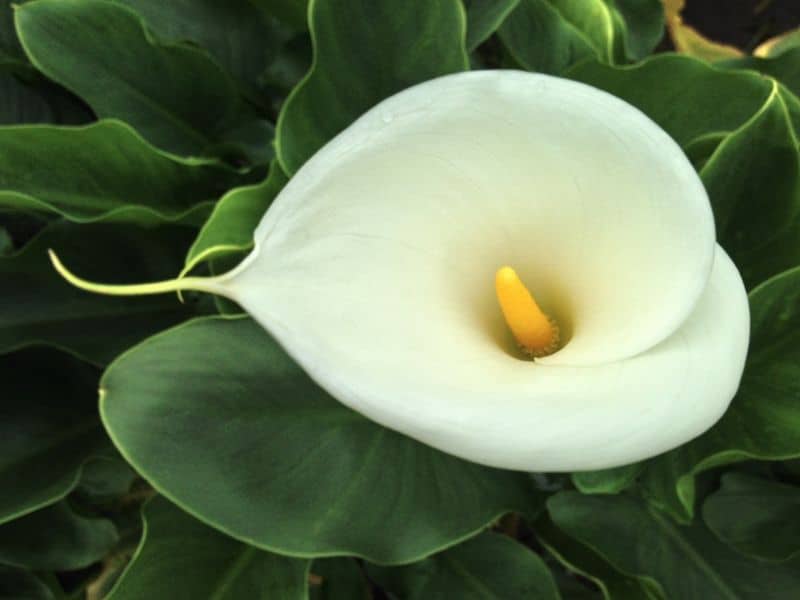
The Calla Lily is also known by the names arum lilies or Zantedeschia. They tend to have waxy white flowers, generally pure white. The leaves are arrow shaped and are a deep green.
Calla lilies often need to be grown in a greenhouse, but some do well in moist or boggy conditions, such as near a water feature or pond.
Camellia

The Camellia flowers have a characteristic glossy leaf and are classified as evergreens. These are long-lived plants that typically flower between fall and spring, with bright blooms that are white, pink, crimson, or derivatives of these colors. They grow well in container gardens as well as in a mixed shrub border.
Candytuft

The Candytuft plant is also known as iberis. These small plants are generally less than a foot tall and are classified as hardy annuals.
The flowers have a sweet smell and come in colors such as white, pink and purple. The plants do well even in poor soils and self-seed readily, so you might find yourself with plants springing up every year.
Canna Lily

Canna Lilies are also known as Indian shot. These exotic-appearing plants feature flowers with bold colors atop tall stems, with some reaching four feet tall.
The blooms are usually yellow, red, or orange, with some species having bicolor flowers or ones streaked or spotted with colors. The foliage may have bronze or purple tinges.
Cape Leadwort
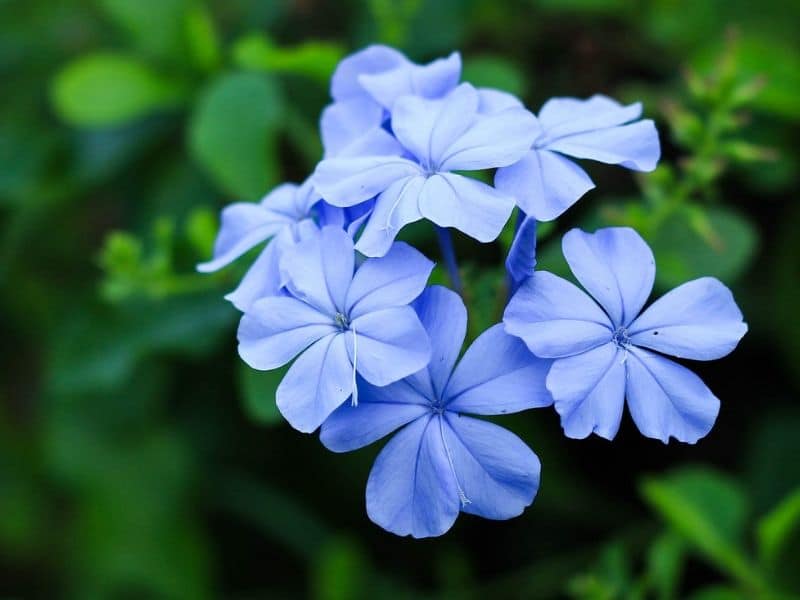
Cape Leadwort, which is also called plumbago, is an evergreen climber. The flowers produced are starry, sky blue flowers that it produces between the middle of summer and fall.
The plant should be pruned regularly, and the plant may get to 15 feet high. It will tolerate light shade but prefers full sun.
Cape Primrose
The Cape Primrose, or streptocarpus, is a group of flowering plants that can readily be grown in many heated greenhouses. The flowers feature a distinct lip similar to that of an orchid.
They come in many colors, such as red and purple. Many of these plants hail from South Africa and need a warm climate to thrive.
Cardinal Flower

The Cardinal Flower, Lobelia cardinalis, is a lovely flower. There are approximately 400 species, and it tends to have dark green leaves and bright red flowers.
It grows in full sunlight or even partial shade. They will flower for a long period of time, generally throughout the summer and part of the fall.
Carnation

Carnations belong to the genus Dianthus. These flowers are commonly used in cut flower arrangements and come in a variety of colors, as well as some being variegated or veined with contrasting colors.
The foliage is gray-green and stems don’t generally get above 12 inches tall. The flowers are often heavily scented.
Catharanthus

The Madagascar periwinkle or Catharanthus is a flower that quickly spreads. They are considered half-hardy annuals, and the flowers may be rose, mauve, or white flowers.
When grown outside, the plant needs full sunlight to grow. The flowers will appear during the summer months and need good drainage or the roots may rot.
Catmint

The catmint or catnip herb is a perennial plant that is native to Europe and Asia. There are several species, all of which tend to be low-growing.
The tubular flowers that are produced during the summer may be white, pink, or purple and are shaped in spirals or whorls. The leaves and stems of the plant are covered in fine hairs.
Celosia

The Celosia flower is also known as the Prince of Wales’ Feathers. The plume-like flowers range in color from shades of reds, oranges, and yellows.
While tall forms of the plant can reach approximately 30 inches, the dwarf forms are less than a foot tall. These plants are annuals that require sun to grow well.
Cerastium Tomentosum

The Cerastium tomentosumis also known as snow in summer. The plant produces silver-gray leaves, and the plant develops sprays of white flowers.
These blooms appear during spring and summer. The plant creeps low and the stems will put down roots as they spread. It can be an invasive plant but suppresses weeds nicely.
Chicory

The Chicory plant is a perennial plant that can be grown as an annual. This plant tends to be large, reaching 3 to 5 feet tall. The finely petaled flowers are sky-blue in color and bloom in summertime.
The flowers open during the morning but close up during the hot sun of midday. The root can be used as a substitute for coffee, and leaves and flowers can be eaten.
Chionodoxa

The glory of the snow plant or Chionodoxa grows from a bulb. It produces star-shaped flowers that are blue in color with white centers.
The flowers usually number a dozen or so blossoms on each spike. Some species may be white or purple-pink, and the stamens appear tipped in gold.
Chrysanthemum

Chrysanthemums originated thousands of years ago in China before being brought over to Japan. They are commonly used as a cut flower in arrangements or grown as a border flower.
Colors of these plants vary and include white, yellow, pink, lilac, and mahogany. The plant comes in many forms as well, such as pompon and anemone centered.
Clarkia
The Clarkia plant is also known as farewell to spring. It is a member of the evening primrose family and attracts beneficial pollinators, such as butterflies and honey bees.
This wildflower can range in size from 6 inches to 3 feet tall, and it has cup-shaped flowers that tend to range in color from pink to a deep red.
Clematis

Clematis is a popular climbing plant, and there are over 200 species, with countless hybrids and cultivars.
Large flower hybrids tend to be the most popular and flower during the summer, with a range of colors including purple, white, and red. The plant prefers to have its roots in the shade while the top growth is located in full sun.
Clover
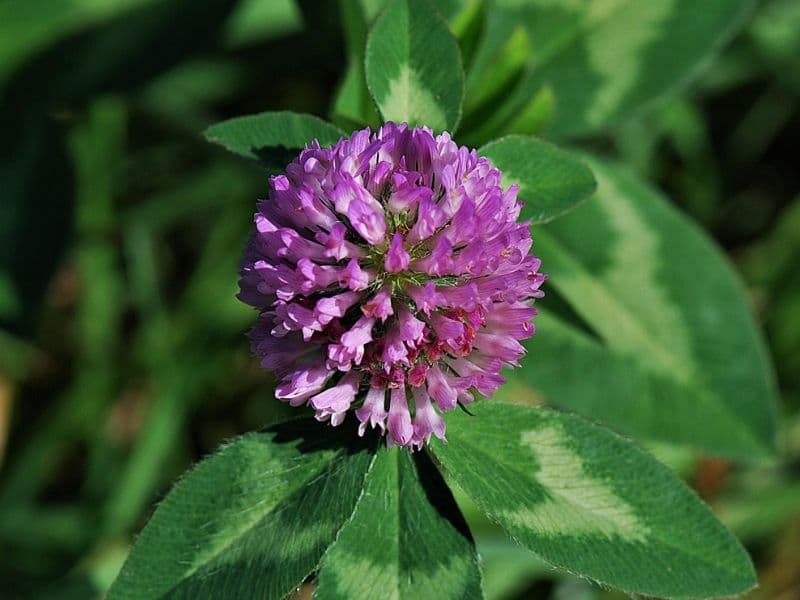
Clover plants fall within a genus that is made up of around 300 species of flowering plants. These are all related to the pea family, and they can be found in areas throughout the world except Australia and Southeast Asia.
The plant makes an excellent cover crop and is also used to feed livestock, but it can be a lovely, easy-to-grow addition to any garden.
Columbine

The Columbine is known by many names, including aquilegia and granny’s bonnets. While the foliage is blue-green, the flowers come in single colors and color combinations, including pink, blue and combinations of brighter shades. While these are not a long-lived plant, they are relatively easily grown from seeds and prefer some shade.
Coneflower

The Coneflower is also known as Echinacea and is native to the United States. This plant produces a cone-shaped center that is surrounded by pink petals.
These flowers bloom over a long period of time, which makes them a great border flower. These plants prefer full sunlight to getting any shade. There are many varieties and the purple coneflower is one of the popular ones.
Coral Bells

Coral Bells, or Heuchera, is a perennial that flowers a rosette of leaves. The foliage is evergreen, while the flowers , which rise above the foliage, can be red, pin, or white, depending on the cultivar.
The plant will tolerate some shade, but it prefers sunlight, which also allows the plant to be presented in the best light.
Coral Vine
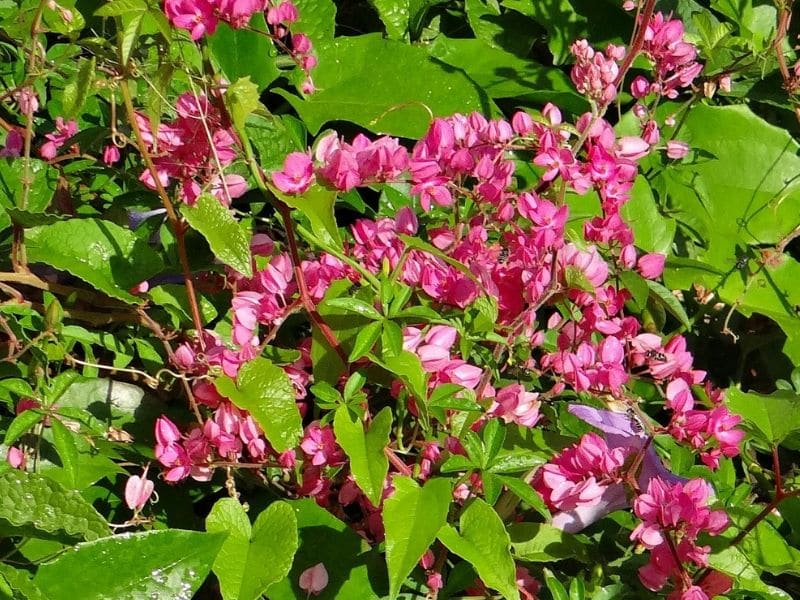
Coral Vine or Berberidopsiscorallina is a plant from Chile. This evergreen climber produces long, pendulous red flowers, and it can reach heights of 15 feet.
It should be grown in a shady area that is protected from cold winds for best results. The plant is low maintenance, needing little care such as pruning.
Coreopsis
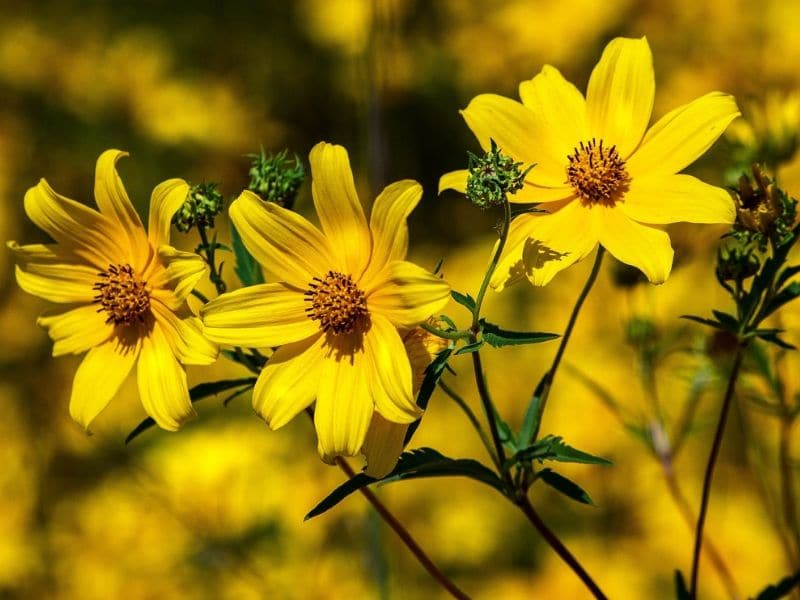
Coreopsis is a plant that blooms over an extended period of time, generally summer into fall, with some plants flowering as early as the spring.
These plants form bright yellow blooms that are like daisies. Some of these plants feature a dark eye, while in others, the eye is yellow to match the flower petals.
Cornflower

The Cornflower or Centaurea cyanus is a hardy annual that tends to be easy to grow. You can grow them for cut flowers or use them in containers or bedding.
There are mixtures and single colors available, with flowers produced in colors such as blue, white, red, and pink. They bloom from summer until early fall.
Corydalis

The Corydalis plant has tubular flowers that are spurred, and there are around 300 species of corydalis. The foliage is fern-like in appearance.
The flowers may be yellow, pink, blue, or white. They may grow between 6 inches and 2 feet high, and these plants are great as plants in rock gardens.
Cosmos

The Cosmos is one of those perennial flowering plants that delights the eye with a simple daisy-type flower and a pleasant, wispy foliage. There is also a variety that comes in a cupcake shape with double petals.
The plants are well adapted for containers and as border plants. Blooming lasts from the middle of summer to relativity late in the season.
Cotoneaster

The Cotoneaster is a family of plants that range from “dwarf” varieties that are only a foot tall to bushes that will tower over your yard at over 10 feet tall.
During the spring, these plants produce sprays of small white flowers, while they produce red and yellow fruits during the winter time.
Crocosmia

The Crocosmia is also known as the montbretia. These plants have a tendency to become invasive. The flowers and foliage of these plants arch slightly, with some ending up at 2 to 3 feet tall.
Many of these types of plants have red-orange flowers atop a stem, and the flowers open progressively from the base to the top.
Crocus

The Crocus is one of over 80 species of flowers that generally bloom between late winter and spring. Some do bloom in the fall.
The foliage is short, and the flowers are small and goblet-shaped. They can occur in a variety of colors, from blue and purple to yellow or cream. Some even have feathering on the petals.
Crown Imperial
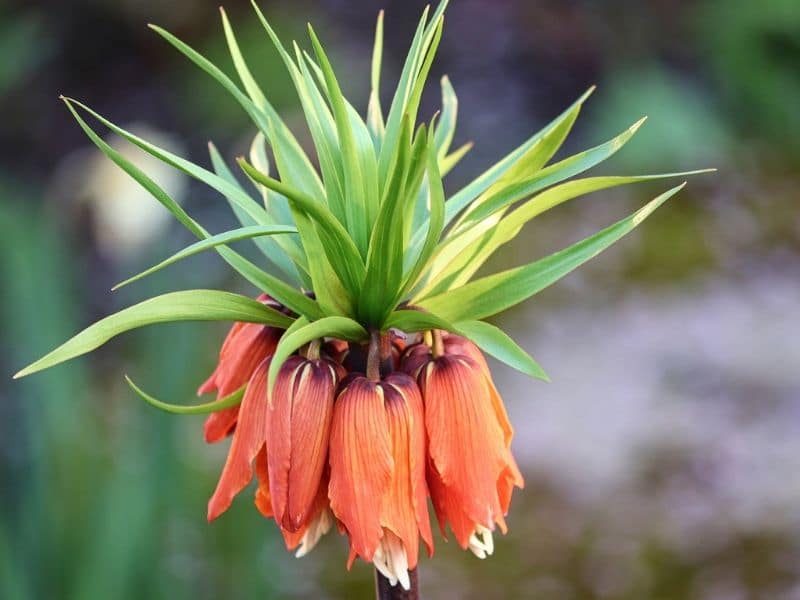
The Crown Imperial goes by other names, including the snake’s head fritillary or the fritillaria. The flowers of this plant feature a checker box pattern, and they bloom from bulbs.
Related to the lilies, different species of these flowers vary in size, with the Crown Imperial being a tall, stately flower.
Cuckoo Flower

The Cuckoo Flower produces loose clusters of white flowers, which have four white petals and tend to be rounded.
Some flowers have a notch in the petals. The center of these flowers are made up of a light green style and 6 cream-colored stamens. They are related to mustard plants.
Cyclamen
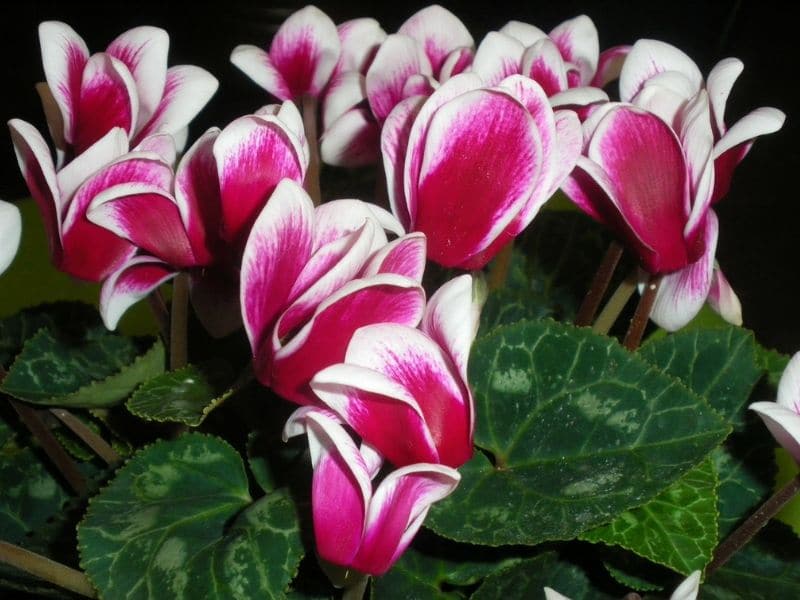
The Cyclamen is a group of plants that are characterized by having largely marbled foliage. The flowers are unique, with their swept back and twisted petals.
The plants range from having large flowers to having small flowers that only get to several inches high. Depending on the species, they flower in fall, winter, or spring.
D
Daffodil

Daffodils are one of the most common bulbs planted in the world. The most common color for these plants is yellow, with the bloom usually having two contrasting shades of yellow.
The flower blooms atop a stem that may be only three inches tall in dwarf varieties or 20 inches in taller plants. Did you know that daffodil is March Birth Flower?
Dahlia

The Dahlia is a tuberous perennial flower that is native to Mexico and South America. The plants form leafy stems and come in sizes from dwarf to large with a huge variety of flower shapes.
There are many hybrid dahlia varieties on the market, which includes at least 42 species. The array of colors is vibrant and impressive and come in all shades and hues except blue.
Daisy

Daisies belong to the family Bellis and are perennials. These spread and come in a variety of colors, such as white and pink, or even bicolored.
Petals range depending on the species and can be tubular or even needle-like. They grow well with plants like tulips in sunny and warm locations in your garden.
Dandelion

The Dandelion is a commonly found plant throughout the world. It is often seen as a nuisance plant or weed, but it can be edible. The leaves should be picked when small, so they are still sweet.
You can also use the flowers to make a dandelion-based wine. The flowers are flat and yellow, and the plant has a fleshy taproot.
Daphne

Daphne is a lovely plant often grown for its fragrant blooms. The plants have upright stems with roughly star-shaped purple-red flowers.
The different species bloom between February and June, and they’re convenient flowers as they don’t typically need to be cut back regularly other than to keep the bushy plants tidy.
Daylily
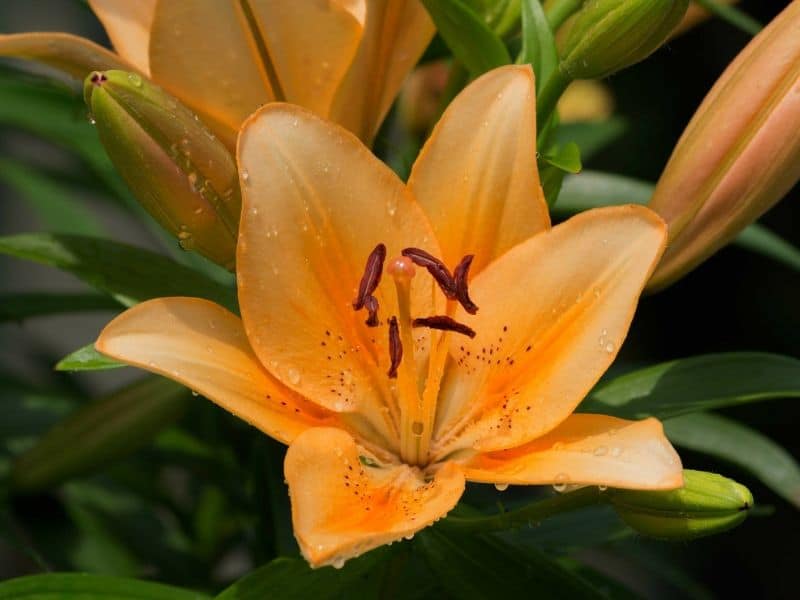
The Daylily is not a true lily. So named because most flowers wither within a day of blooming, these plants belong to the genus Hemerocallis.
Some bloom only at night, and these varieties are often more fragrant than the day-blooming plants. You will find a range of colors for daylilies, and each plant tends to bloom repeatedly over an extended period of time.
Decumaria

The Decumaria plant is a climbing plant and a deciduous one. It is native to the southeastern United States, and the plant produces aerial roots.
The plant produces fragrant flowers that are cream in color during the early summer months. It can grow to 30 feet high, making it an excellent climber.
Delphinium
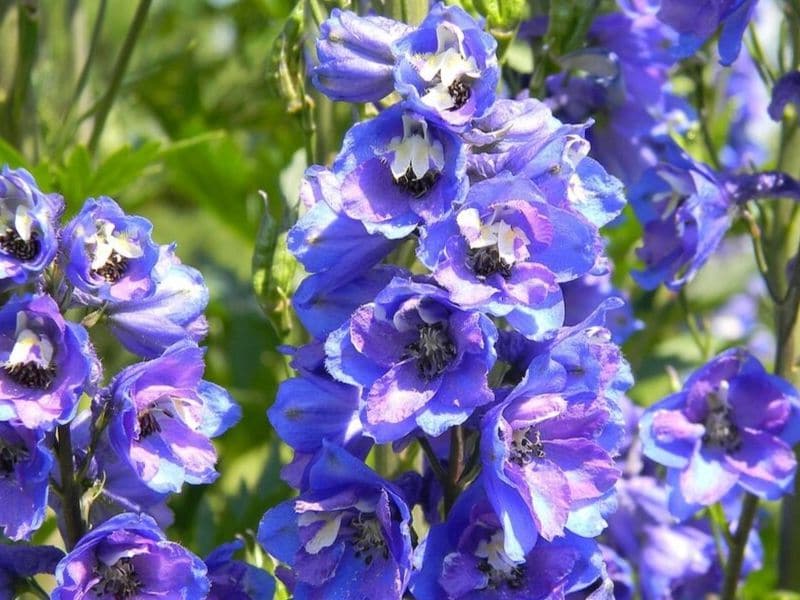
The delphinium is a tall flower, growing around 39 to 78 inches tall. The plants produce spires of long-lasting blooms from late spring to early summer.
Originally these were solely a blue plant, but cultivars offer shades of pink, white, and red. These plants do well with some climbing plants such as clematis, but tall flowers may need to be staked.
Desert Rose
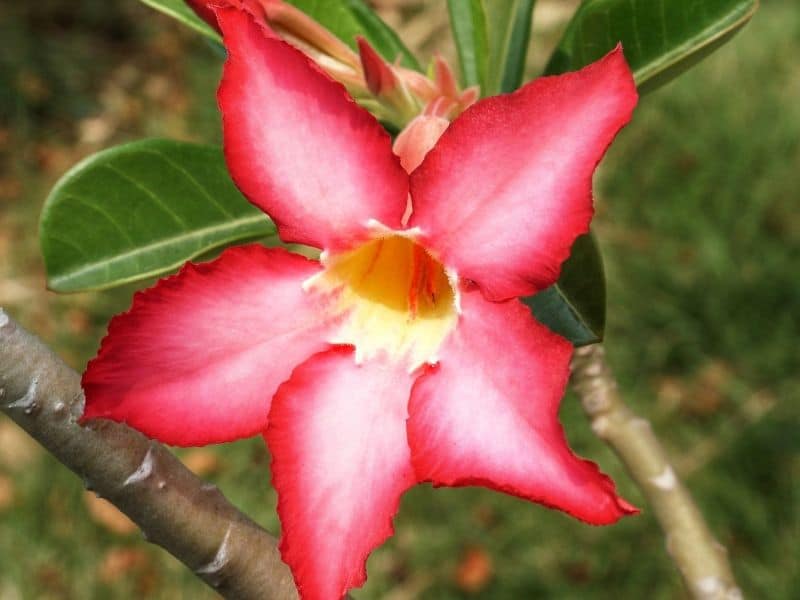
The Desert Rose, or Adenium obesum is a plant that also goes by the name impala lily. This succulent plant produces colors that vary from pure white to a deep red. They are very easy to grow and can be trained to be bonsai trees.
Rather than being related to roses, this plant is related to periwinkles and oleander. These succulent plants are hardy and can even tolerate some benign neglect.
Deutzia

The Deutzia plant is a plant that is easy to grow. It blooms profusely, and the plants are deciduous. They may be upright or rounded.
There are different species of flowers, and many of them are white, while others may be a carmine pink color. One species, the Pride of Rochester may grow to 7 feet high.
Dianella

The Dianella plant is also known as the flax lily. This plant tends to bloom in February through April where it grows best.
They do well in partial shade and grow up to two feet tall. While they need some moisture, these plants do best with well-draining, dry soil rather than soil that is damp all of the time.
Dianthus barbatus

The Sweet William or Dianthus barbatus plant is a colorful flower with large, rounded flower heads. The blossoms may be pink, white, burgundy, or even bicolors, and the plants tend to have darker, centrally located eyes. Some varieties are so dark they are almost black. There are dwarf and taller varieties.
Diascia

Diasca, or twinspur, last from the spring until the first frosts of the fall, so you will get a long flowering cycle from these lovely little flowers.
The flowers are shades of pinks, and they tend to be short plants, roughly 6 to 12 inches high. If you cut them down after flowering, you may get a second round of flowering.
Dietes
The Dietes plant is from southern and eastern Africa before it spreads in gardens around the world. This plant produces white flowers with yellow and blue markings.
The plant does well in full sun to partial shade, and while they do well in some zones, you should dig up the rhizomes in cold climates to overwinter them.
Dill

Dill is an herb that can grow up to 2 to 3 feet tall. It looks similar to the herb fennel, with feathery leaves that are blue-green and aromatic and yellow flowers.
The plant has a thin taproot that forms a long stalk. The mass of tiny flowers appear in clusters at the top of the stalk. Small, brown seeds are produced in large numbers.
Disa

There is only one species of Disa plant commonly cultivated. These have scarlet flowers with a red and gold venation. Under natural circumstances, yellow ones may also be found.
A relative of the orchid, it can be difficult to propagate these flowers as they require soil that is constantly damp but never waterlogged.
Dutch Iris

The Dutch Iris is a type of iris that produces blue, yellow, or white blooms. These plants grow one to two feet tall, and they need full sun to grow well.
They don’t spread much, only about half a foot at most, and you grow them from a bulb. They need well-drained soil to grow well, and they bloom between May and June.
E
Echinops
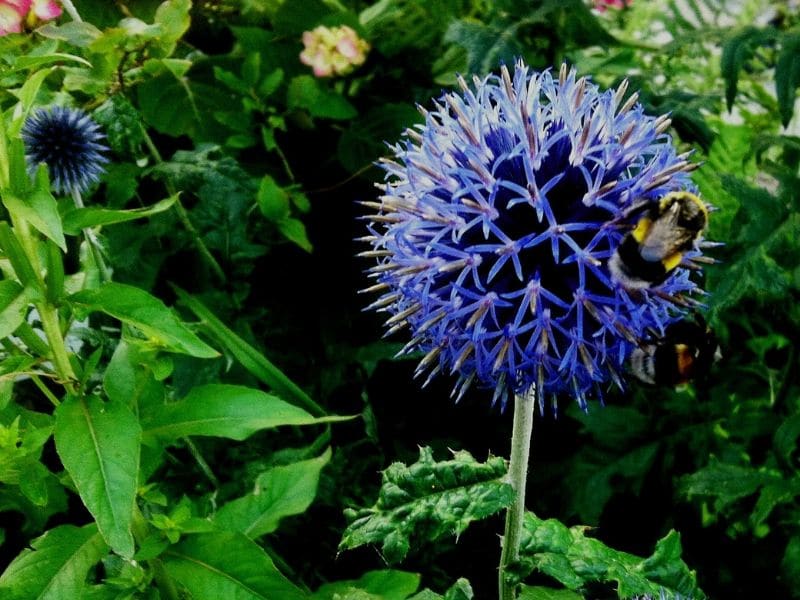
The Echinops plant is also known as the globe thistle. This distinctive plant has silvery colored stems, with hairs on the foliage, that range in height from one foot to over 6 feet tall.
The flower heads can be white or a bright metallic blue color. They are often dried and used as part of flower displaces.
Echium

Echium is more commonly known as the pride of Madeira. The plant gets to be 5 to 6 feet tall, and spreads to between 6 and 10 feet.
The plant’s blooms are bluish purple to white, and the plant does best with full sun. It will attract pollinators such as bees, butterflies and birds, and it is deer resistant.
Elder

Elder is a Sambucus species that is referred to as elder or elderberry. The plant grows as either a shrub or a tree.
The flowers are attractive to pollinators like bees, while birds commonly eat the berries. The plant can be eaten, with such foods as elderflower win or elderberry jam and has medicinal uses.
English Bluebell

English Bluebell is also known as Hyacinthoides. This plant grows from a bulb and is an excellent species to grow under deciduous trees or in drifts in the yard.
The plants have delicate, scented, blue blossoms, although there are cultivars with white or pink flowers that are not as popular.
Epimedium
The Epimedium plant is also known as the barrenwort, and it is a low-growing perennial. This is one plant often grown for its foliage, but many of these plant species have small, starry flowers that may be yellow, cream, or pink as some possibilities. Some are evergreen, but others die during the winter.
Eremurus
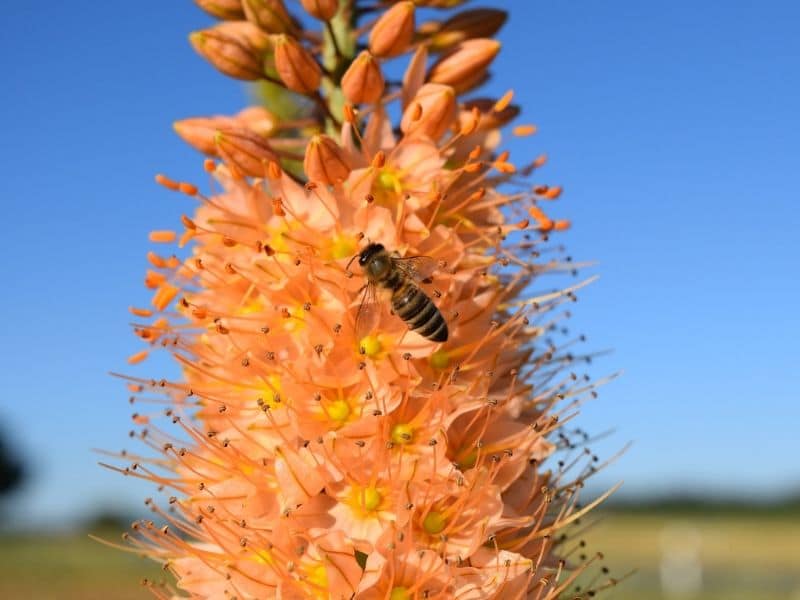
The foxtail lily or Eremurus is a stately flower, the tallest of which is Eremurus robustus. These plants produce star-shaped flowers, which may be a variety of colors such as yellow, pink, and orange. These tall plants are prone to being damaged by wind and should be planted in a protected area.
Erica
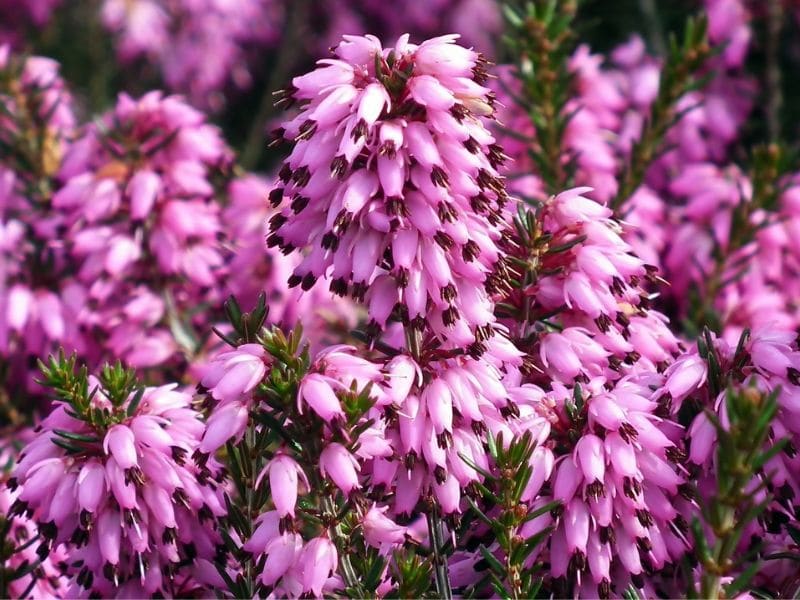
Erica is also referred to as winter or alpine heath. The plant is an evergreen shrub that can spread to around 20 inches. The plants range from having dark green foliage to bronze tinged foliage.
These vibrant flowers may be colors such as pink, red, or white, and you can mix and match the colors for a veritable patchwork in your yard or garden.
Erigeron

Erigeron is a herbaceous perennial that is also known as Robin’s plantain. It is natively found in the southern and eastern United States.
The blooms produce pale violet rays that are arranged around a central yellow disc. They prefer full sun, and these beautiful plants will attract pollinators like butterflies.
Euphorbia

The Euphorbia genus contains a large group of plants known as Spurge that are shrubs, annuals, perennials, and “subshrubs”.
They are tree-like succulents and can grown under a wide range of conditions, such as shade or full sun. Some produce yellow-green flowers, and they can spread to form a large colony.
Eustoma
Eustoma is also known as lisianthus, and it is an herbaceous perennial that grows up to 3 feet high. The flower blooms are pale purple, and these plants have an extended bloom time, from early spring until the first frost of fall. They do tend to be high maintenance flowers though.
Evening Primrose

Evening Primrose is a Oenothera plant. These plants are a major feature of cottage gardens, and they come in colors such as yellow, white, and pink.
The blooms open and close fast, generally in less than 24 hours, but there is a dearth of blossoms that will grow and bloom on each plant throughout the season.
F
Fall Crocus
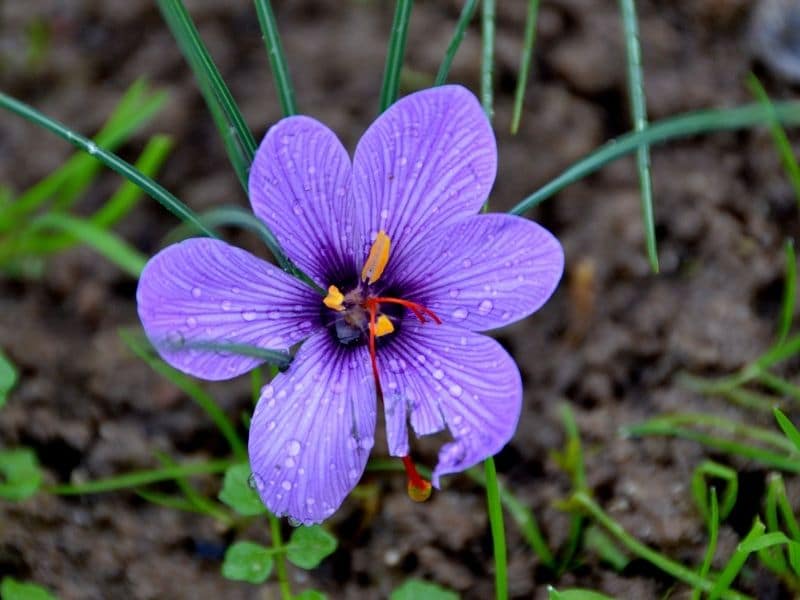
The Fall Crocus is also known as meadow saffron or Colchicum autumnale. The plant has its flowers emerge directly from the corm, and the leaves don’t appear until later.
These are not related to true crocuses. The plants bloom with pink to lilac to white flowers. The bulbs tend to be easy to care for.
Feverfew

Feverfew is a perennial flower that has aromatic and finely cut leaves. The blooms are clusters of small white daisy-like flowers that are produced during the summer.
While most plants have green leaves, some varieties do have golden foliage. The plant is commonly used as a medicinal herb to treat issues such as indigestion.
Firethorn

Pyracantha or the Firethorn is often used as a screening or hedging plant. The stems have small, green leaves, and the plants produce clusters of white flowers.
During fall and winter, the plants produce berries that may be bright orange, red, or yellow. Birds are often attracted to the plant to eat the berries.
Flaming Katy

The Flaming Katy or Kalanchoe blossfeldiana is most commonly used as a potted plant in gardens. The leaves are scalloped, and many times, you’ll find the leaves edged with a tinge of red.
While the original species produced red flowers, you’ll find hybrids in an assortment of colors, including white and pink.
Flannel Flower
The Flannel Flower is a plant native to Australia and New Zealand. It got its name due to the soft “wooly” feel of the plant. The main cultivar is known as Federation Star.
The entire plant is covered in small, soft, white hairs that give it its texture, and the plant can be a large plant or small shrub.
Flax Flower

The Flax Flower is native to areas of California, and it is a small plant belonging to the species Linumlewsii. The plant produces small flowers that are pale blue and roughly an inch and a half in width.
The flowers bloom from the bottom of the plant upward, and the plant tends to lean rather than remain upright.
Flowering Dogwood

Cornus or the Flowering Dogwood is a tree that heralds spring in well. The flowers are powderpuff blooms in white to sulfur yellow that brighten up the tree limbs.
The plant forms small fruits during the fall that are edible, commonly used in jams, and are small, red, cherry-shaped fruits.
Forget Me Not

The Forget Me Not is a lovely flower that is considered an invasive weed in some areas of the United States. They produce blue, white or pink flowers.
They enjoy either full sunlight or dappled sunlight, such as in beds with shelter from trees. They readily self-sow, so remove all plants if you don’t want them there the next year.
Forsythia

Forsythia comes in many different species and cultivars. The plant is a deciduous shrub that typically gets to a height of two feet and a spread of four feet.
It is low maintenance and requires full sun or partial shade to do well. The flowers bloom their yellow blooms between April and May.
Four O’clock

Four O’clock flowers are perennials and members of a 45-species family called Mirabilis. The flower originated in tropical America and is commonly found in Mexico, Arizona and Texas. They are also known as Marvel-of-Peru and beauty-of-the-night.
Four O’clock flowers bloom in the late afternoon, are known for being fragrant and bloom in a wide variety of colors such as white, yellow, red and pink. Some flowers are streaked in or mottled with color. Trumpet shaped flowers bloom in summer.
Foxglove

Foxglove is also known as digitalis. These plants may self-seed, so you might get more than you expected the following years.
They have tall spires with richly colored flowers, and they will grow under most growing conditions, including dry or damp soils. The plant is toxic and should not be consumed.
Frangipani Flower

The Frangipani Flower is also known as Plumeria or templetree. This plant is a tree that is a seasonal bloomer, with red and pink blooms.
As a flowering tree, it is decorative and fragrant, blooming seasonally. It needs full sun. The native range of the Frangipani Flower is between Mexico and Panama.
Freesia

Freesias are highly regarded for their distinct fragrance and their beautiful flowers. The plants come in a range of colors, especially modern cultivars.
You can find blue, mauve, purple, and pink, while wild species are typically yellow or white flowers. They need to be sheltered when growing outside, such as in a sheltered border.
French Marigold

The French Marigold belongs to the family of Tagetes plants. They tend to be easily grown plants, found in bright colors such as orange, red and yellow.
The dwarf plants may only get 6 inches high, but tall plants get to be over 3 feet tall. They need full sunlight to grow well, and their flowers can be 3 inches across.
Fuchsia

The Fuchsia (sometimes known as fuschia) plants are also known as lady’s eardrops, given the blooms shape and color pattern. The blooms can be bicolors, as well as red, purple, and pink.
They are seasonal bloomers that do well when planted in full sun to partial shade. Overwintering them can be tricky in cooler climates and requires putting the plant into a dormant period.
G
Gaillardia
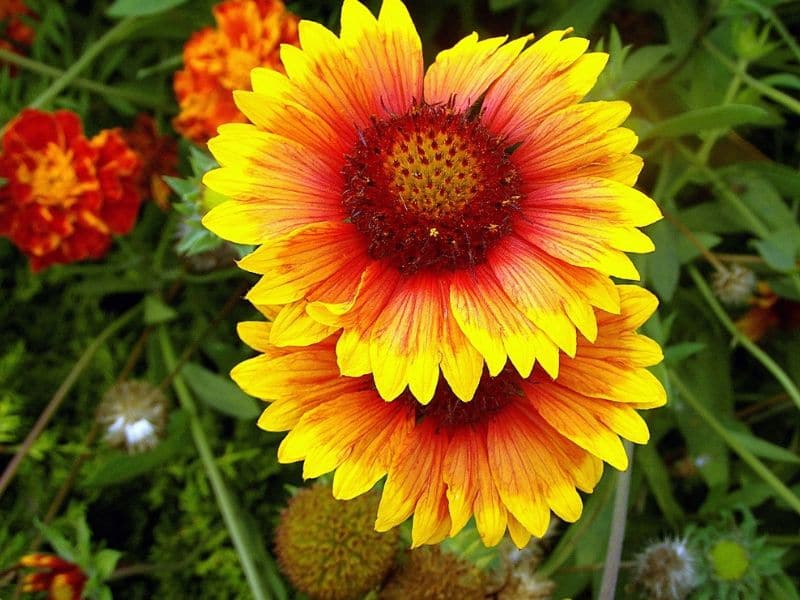
Gaillardia also goes by the name Indian Blanket. This plant is a wildflower found throughout areas of the United States, including Virginia and Arizona.
It is a red or yellow plant with bicolor features and generally a darker center. It needs full sunlight but will bloom from June until the first frosts of fall.
Gardenia

Gardenias are a popular flower. They have white or ivory flowers that bloom seasonally. They were natively from China and Japan.
These plants are considered a broadleaf evergreen, and they need partial shade. The flowers are prized because they are fragrant and showy, and when cut, they make an excellent cut flower for your display.
Gazania
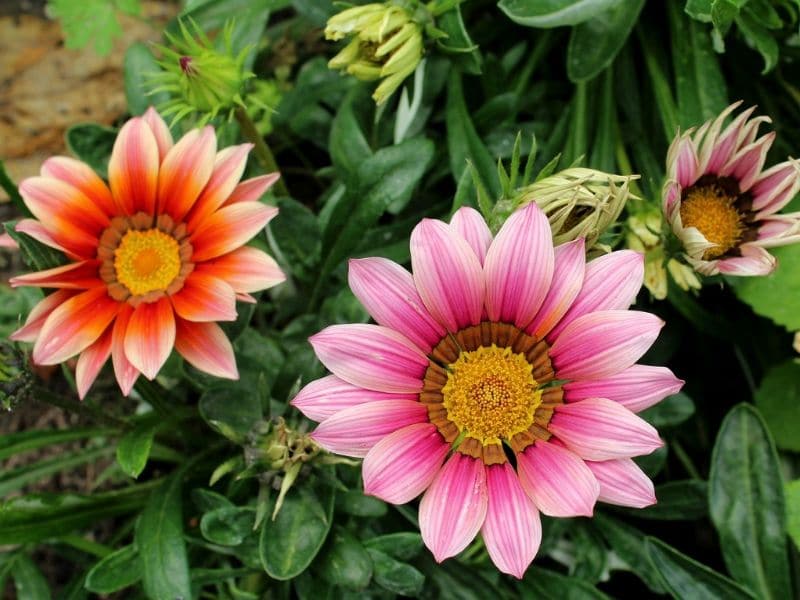
The Gazania plant is often brightly colored plant. You may find it in colors such as red to pastel pink. The flowers have an eye that is a contrasting color.
Gazania flowers bloom throughout the summer, but the flowers do not do well as a cut flower. They need direct and “roasting” sunlight to reliably open.
Geranium

The Geranium is also known as the cranesbill plant. This flower is a hardy perennial that tends to flower for a long period of time.
Dwarf species may be 6 inches tall, while other geraniums get to be around 39 inches tall. Flowers may develop in a variety of shades, including violet, pink, and rose.
Gerbera Flower
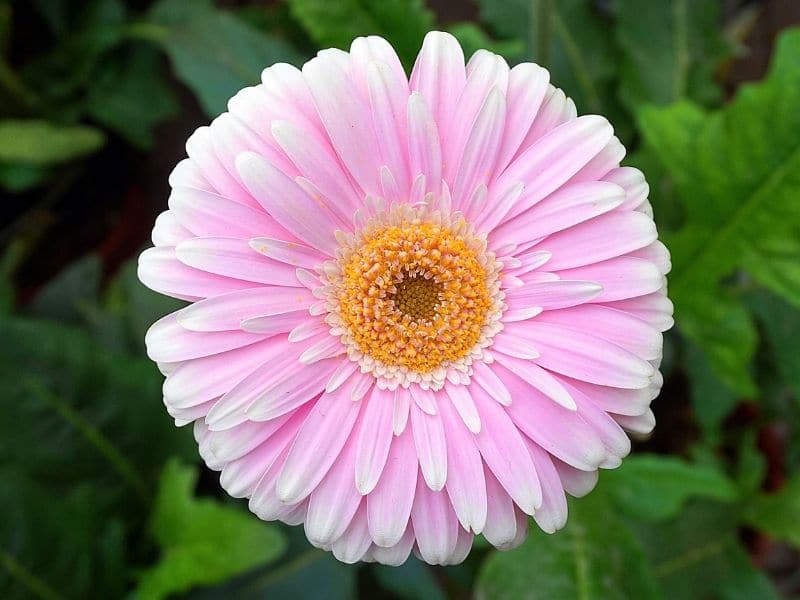
Gerbera Flowers are also referred to as transvaal daisies. These plants are seasonal bloomers, and the blooms are red, yellow, or orange, with a bronze-yellow disc in the center of the bloom.
From Southern Africa, these plants do well in full sun to medium shade and are considered pretty low maintenance.
Gladiolas

The Gladiolas (or Gladiolus) commonly cultivated came from South Africa, although other species and cultivars come from the Mediterranean regions and western Asia.
There are around 300 species, but most modern ones grown are hybrids. You can find them in just about any color from pink to yellow to green, and many are bicolored.
Goldenrod

Solidago or Goldenrod is a plant that can form large colonies of these bright yellow flowers. The plants come in different heights, which may make a difference in your garden.
They need full sunlight to grow well, so the gardens that you plant them in should not have shade over the areas you want your Goldenrods to grow.
Grape Hyacinth

The Muscari or Grape Hyacinth is an easy to grow plant that features blue flowers. Some like the Plumosum variety are feathery.
Some even have pale blue flowers at the top of the spike and dark blue at the bottom, providing a lovely contrast in your garden. These plants grow from bulbs, which should be divided every 4 to 5 years.
Guzmania

The Guzmania species are a large group of plants with only a few terrestrial species. The plants have beautiful rosettes that have satiny foliage.
Many modern examples have been hybridized with vrieseas. Plants may grow to be more than three feet wide, and leaves may be green or have patterns like stripes.
H
Hawthorn
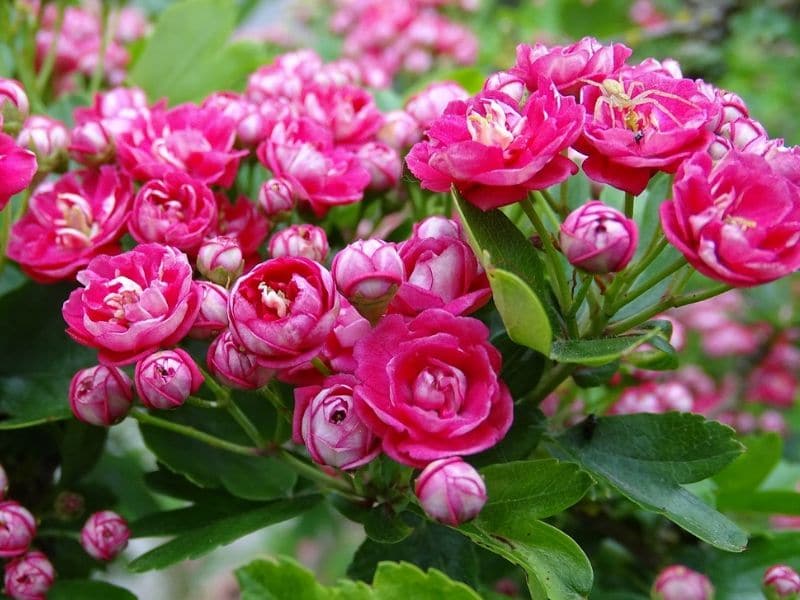
Hawthorn, or Crataegus, is a deciduous plant that can be a shrub or tree, largely depending on how it’s maintained and trimmed back. The plant produces toothed leaves, with red or white blossoms formed.
Orange or red berries are produced that attract birds to the Hawthorn. They flower best when planted in an area of full sunlight.
Heather
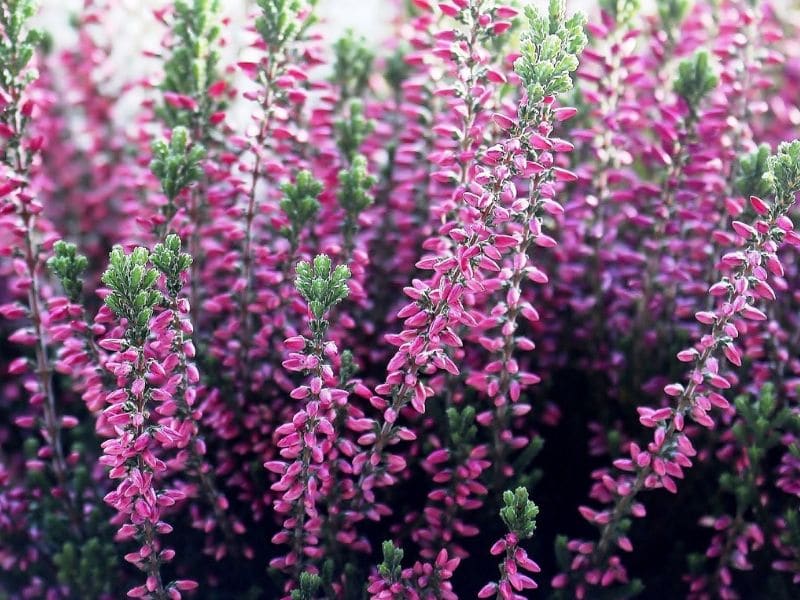
Scottish Heather is a broadleaf evergreen plant. It’s native range is throughout parts of northern North America and northern Eurasia.
The heather flower blooms are a rose to purplish pink color, and the plant grows well in full sun to partial shade. This plant does not do well in high heat and humidity climates.
Maybe you’re interested in: What Does Heather Flower Mean and Symbolize?
Hebe

Hebe is also known as the New Zealand lilac, an evergreen shrub that tends to sprawl when it grows. It isn’t very hardy and does better when it is protected, such as by a sunny wall.
The plant produces a display of lavender blue flowers during the spring and summer. Regular pruning is not needed for these plants.
Helenium

Helenium, or the sneezeweed, flowers from late summer to the middle of fall. It is an herbaceous perennial.
There are a variety of cultivars that produce flowers in bright golden, orange-red, and copper-red blooms. these plants are easy to grow and can form large clumps of flowers in your garden.
Helichrysum

The Helichrysum is also known as the strawflower. Dwarf varieties grow about 6 inches high, while taller varieties can be two feet high.
These plants produce double blooms oftentimes, and the petals feel like straw, hence the name. The flowers can be dried easily and can be used in flower arrangements.
Heliotrope
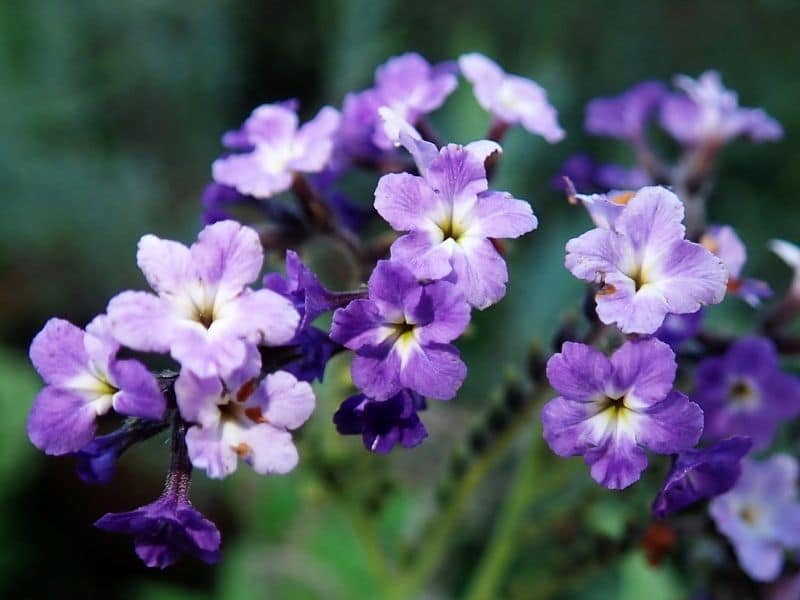
The Heliotrope plant also goes by the name of cherry pie. A Peruvian shrub, the plant has soft stems and often needs to be protected during the winter by overwintering it in a greenhouse.
The flower blossoms are mauve to purple and have a vanilla fragrance, with the plant blooming between summer and fall.
Hellebore

Hellebores go by other names, such as the Lenten or Christmas rose, as they flower in mid-winter or early spring.
Different species have different colored blooms, with such examples as lime-green flowers or mottled color flowers. The perennials tend to be evergreens and most prefer to remain undisturbed when planted.
Hibiscus

Hibiscus is a shrub-type plant that is deciduous and blooms in the late summer. These tropical flowers can be single or double, and the colorways include white, pink, blue and purple.
These are long-lived plants, and they tend to be rather hardy. Unlike many shrubs that spend several years developing, the Hibiscus flowers early in its development.
Holly

Holly, which belongs to the genus Ilex, is an evergreen that comes in many cultivars. The leaves tend to be dark green, glossy, and spiny. The plants produce scarlet or orange berries.
This should be pruned especially in late winter in order to maintain the shrub or it will grow into a tree.
Hollyhock

The Hollyhock is also known by its scientific name, Alcearosea. The plant produces blooms that are white, pink, and red, depending on the cultivar.
It is an herbaceous perennial, and it tends to be high maintenance. The flowers attract hummingbirds and butterflies, and the plant tolerates rabbits and black walnut.
Honeysuckle

Honeysuckle or lonicera is a popular plant that can be trained to climb doors or fences. These plants tend to smell sweetly and attract pollinators, such as bees and butterflies.
The blossoms have a roughly bell-shaped appearance, and the colors can range from white to lilac. Some species even flower during winter.
Hosta

The Hosta is also known as the Plantain Lily. These perennials produce an abundance of attractive foliage.
The plants tend to live for long periods of time, and the different cultivars may have foliage that is green to blue in color. Many of the leaves are variegated, and the leaves can have different textures as well.
Hyacinth

Hyacinths make great plants in container gardens or flower beds. They make excellent cut flowers and are used in many flower displays or grown for their decorative usage as a potted plant.
Colors include blue, pink, white, and yellow. Flowers tend to be crowded on the stem. Bulbs do best their first year.
Hydrangea

Hydrangea produces large blooms of flowers, generally in broadly conical or mushroom-shaped clusters.
The blooms may be white, pink, blue, or red, and they are produced on this shrub which tends to live for a long time. Most common are the lacecaps and mophead types. Some species are climbers, such as the Hydrangea Petiolaris.
Hyssop

Hyssop, which is different from anise hyssop, is a shrub that is semi-evergreen. The plant produces spikes of flowers at the top of each stem, which may be blue-violet, pink, or white.
While the leaves are bitter, there are culinary uses, such as making a tea from the stems, leaves, and flowers.
I
Ice Plant

The Ice Plant is also known as Delosperma. This plant is from South Africa and is a succulent that forms a mat that spreads as it grows.
The plant is often only three inches off of the ground but may spread to two feet. The flowers on the Ice Plant are a glossy red purple color, and it does not do well in moist environments.
Iceland Poppy

The Arctic or Iceland Poppy is an herbaceous perennial. It can grow two feet high but tends to not spread far. The plant’s blooms can be a variety of colors, including white, yellow, orange, pink, and rose.
It needs full sun to grow and tends to be fragrant. The plants do best in areas with cool summer temperatures.
Impatiens

Impatiens are also known as Busy Lizzie. These plants come in a wide range, and they do well in different conditions including full sun or shade.
They can be planted in areas such as flower beds, container gardens, and hanging baskets. These are annuals that can be difficult to raise from seeds.
Ipomoea Lobata
The Ipomoea lobata plant goes by many names and used to be known as Mina lobata. Commonly called the Spanish flag plant or the firecracker vine.
It is a perennial member of the Morning Glory family. It has tubular flowers that change color, and the nectar in the flowers attracts pollinators such as hummingbirds.
Iris

The Iris is a plant that grows from a bulb or rhizome, depending on the species. These plants come in many species and cultivars, with a range of colors, from multi-hued to single, showy colors such as white or black.
The leaves of irises tend to be sword-shaped, although bulbous types tend to have narrow, lance-shaped leaves.
Ixia

The Ixia plant, or the corn lily, is often grown from hybrid varieties. The plant’s starry flowers occur in an array of colors, including white, red, orange, and magenta.
The foliage is narrow and grass-like, and it may be two feet tall, while the flower spikes rise above the leaves.
Ixora

The Ixora plant is commonly referred to as the flame of the woods. This plant is a broadleaf evergreen that flowers throughout the year.
The blooms are red, and the plant tends to be pretty low maintenance, attracting birds and butterflies. It needs full sun and grows best in moist, acidic soils.
J
Jacob’s Ladder

Jacob’s Ladder is also known as Polemonium, and it is an herbaceous perennial. Native to eastern North America, the plant blooms between April and June.
The bloom is blue and does best between full sun and partial shade. The plant grows best in moist but well-drained soil.
Jasmine

Jasmine comes in two forms, the climbing and the bushy plant. When well maintained, the flowers tend to flower generously.
The plant produces a variety of different colored flowers, including yellow, pink, and white flowers. The leaves are green but may be cream-flushed. Climbing varieties can be trained to climb trellises.
Johnny Jump Up
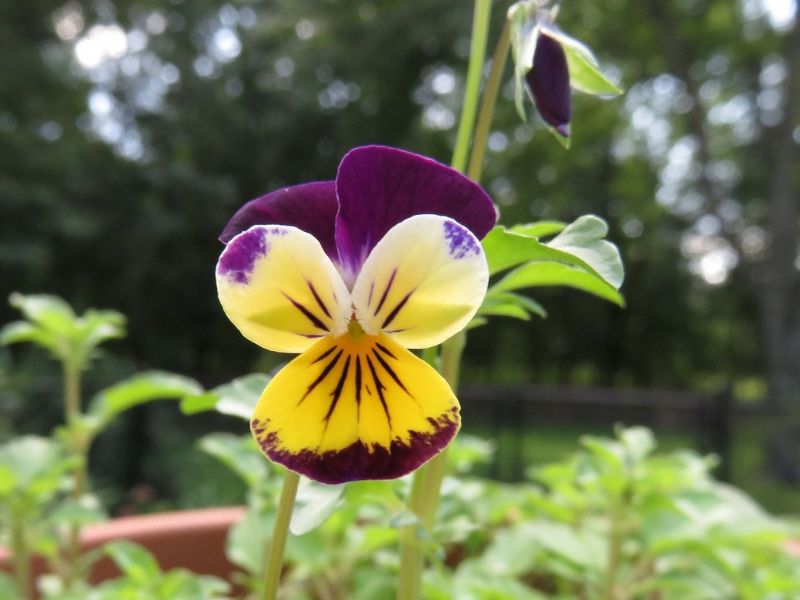
Johnny Jump Ups are small and delicate flowers that are bright purple and yellow. They are known by many names such as Jack-jump-up-and-kiss-me, viola tricolor, tickle-my-fancy, heart’s delight, heart’s ease, heartsease, three faces in a hood, come-and-cuddle-me, or love-in-idleness.
They are easy to grow and are smaller relatives of the pansy. Johnny Jump Ups tend to be more heat tolerant than pansies and produce more flowers per plant than pansies. They do well being planted underneath trees in the shade.
K
Kaffir Lily

The Kaffir Lily is also known as Cliviaminiata. This plant is an evergreen that forms long green leaves that overlap at the base of the flower.
The stem holds roughly 20 flowers that are bell-shaped and orange in color, marked with yellow. Some cultivars exist with yellow flowers and cream stripes in the foliage.
Kalmia

The mountain laurel plant is also known as Kalmia. This plant is a broadleaf evergreen and is native to the eastern United States.
The plant can grow up to 15 feet tall and wide, and it produces rose to white flowers with purple markings. The plant does best in partial shade, and it tends to grow well in moist soils.
Kangaroo Paw

The Kangaroo Paw is the Anigozanthos plant, and it is a perennial from western Australia. A seasonal bloomer, this plant produces a greenish-yellow or occasionally red flower.
The plant grows in full sun to partial shade, and it has an evergreen leaf. It prefers sandy soils and doesn’t tolerate frost at all.
Knautia
The Knautia plant is a perennial that hails from Central Europe. It blooms between July and September, and the flowers are burgundy.
The plant does best in full sun, and the Knautia prefers average, well-drained soils. The flower blooms make excellent cut flowers, and they can also be easily dried for arrangements.
Kniphofia

The Kniphofia plant is also known as the red hot poker plant. These plants are evergreen perennials and also go by the name torch lilies.
They have flower spikes that occur in cream, red, yellow, and orange shades. The stems are high above the foliage and may be as much as more than 6 feet tall.
L
Lady’s Slipper

The Lady’s Slipper is a type of orchid. It is natively from the United States, and it can grow to almost 3 feet tall. It blooms between April and June, and the flowers are a creamy yellow color, with purple-brown sepals. These plants like shade, preferring full to partial shade over sunlight.
Laelia

There are many different species of Laelia, and many of these plants come from Central and northern South America.
The flowers are showy and popular with beginning gardeners, and the blossom colors may be white to pink to purple. Laelia purpurata, also known as the queen of laelias, is the national flower of Brazil.
Lantana

The lantana is also referred to as a shrub verbena. This plant comes from the tropical areas of America, and the flowers bloom between July and the first frost.
The blooms may be white, yellow, red, purple, or orange, and the same cluster will often have mixed colors. They attract butterflies and do well with drought conditions.
Larkspur
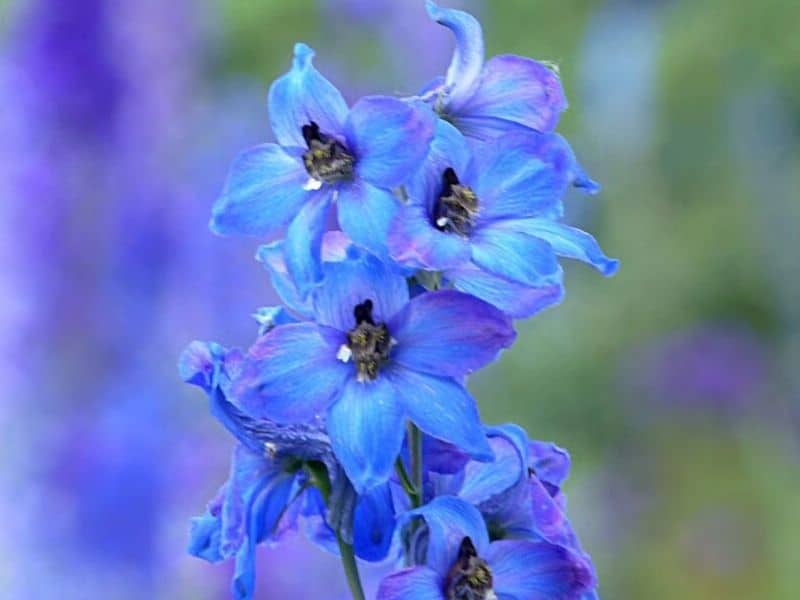
Larkspur is also known as Consolida, and it is a hardy annual plant. These plants grow up to 3 feet tall, and the spikes have flowers that range in color from red to blue to white, and they have single or double flowers. The plants are great for cut arrangements, but use caution with the seeds as they are poisonous.
Lavatera

The Lavatera also goes by the name of the annual mallow. The flowers have a silky sheen and come in colors such as white, pink, and rose.
The different varieties grow to be different sizes, but you’ll usually find them between 2 and 4 feet tall. They are both easy to grow and make good cut flowers.
Lavender

Lavender is a popular plant with a variety of uses, including making essential oils and for decorating.
The lavender plant is a relatively hardy evergreen, with foliage that is gray-green, sometimes with a silvery color to the leaves. The blooms are usually pale blue or purple but can also be white.
Lemon Verbena
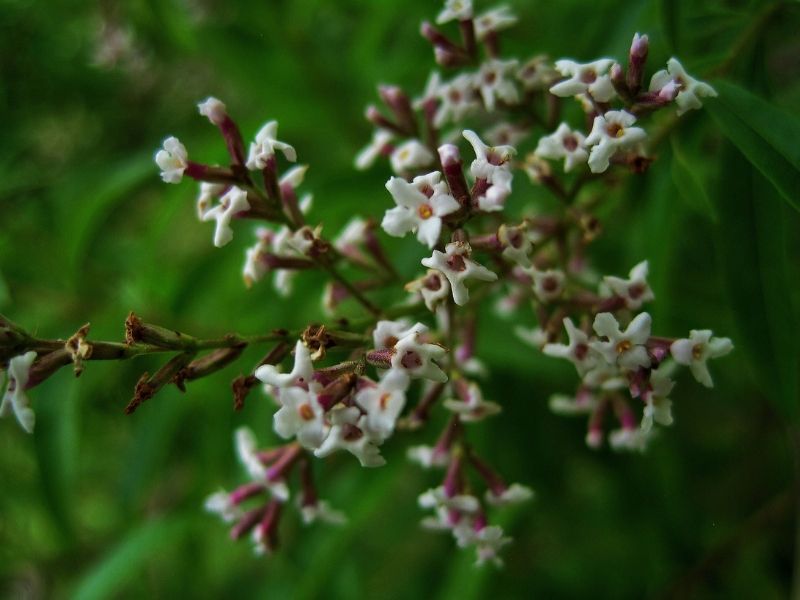
The Lemon Verbena is a deciduous shrub that can grow up to 10 feet high. The plant produces long leaves with a lemon scent.
Sprays or spikes of flowers develop that are white to mauve and tend to be small. The plant’s leaves can be used fresh or dried in dishes and herbal teas, and essential oils can be made.
Lewesia

The Lewesia plant is native to America. The plant grows best in rocky environments or on well-drained slopes, and the plants are typically low growing.
The flowers are bright and funnel shaped, with most blossoms a pink or magenta color. These plants are known for hybridizing readily, which can produce interesting variations.
Lilac

The lilac is a family of flowers coming from Europe and Asia. They produce a plume of flowers that blossom between May and June.
These lilac plants come in a variety of colors, including pink, purple, and cream, and they may grow to 10 feet high. They prefer full sun but will also grow in areas with light shade.
Lily of the Valley

Lily-of-the-Valley is also known as Convallaria majalis. There is just one species in the genus, and the flowers produced are bell shaped.
The can spread readily, especially with ideal conditions for the plant which include a cool, moist environment. This is a plant that loves shade rather than full sun.
Lily

Lilies produce iconic trumpet-shaped flowers on their stems, usually producing multiple flowers on each stem. The stems can grow tall, with some towering over 6 feet tall.
These are often fragrant flowers, and they come in colors such as white, red, and orange, with solid, spotted, or even streaked petals.
Linaria
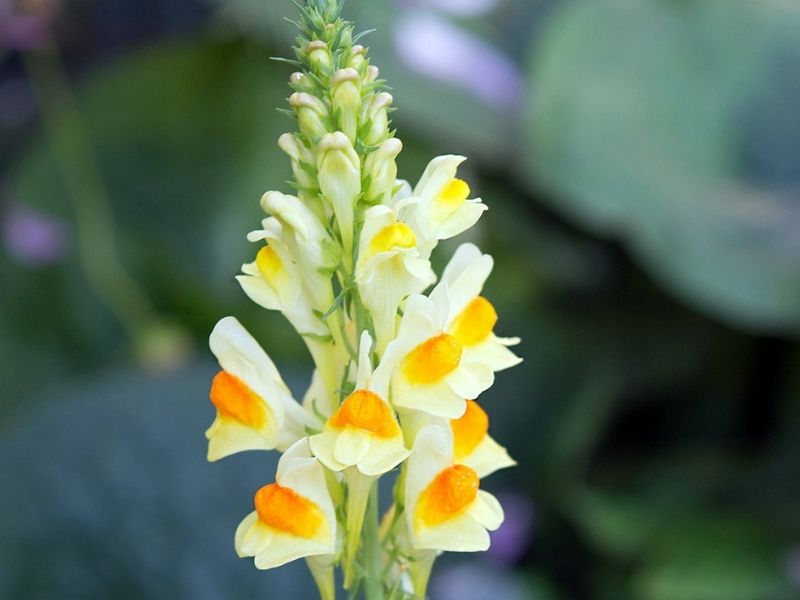
Toadflax, also known as Linaria, produces small flowers that look similar to small snapdragons. The flowers come in multiple colors, including blue, yellow, pink, and white.
These plants are hardy annuals that you can directly sow in the soil outdoors. They will also self-seed readily. Toadflax needs a warm and sunny spot to grow.
Lotus

The lotus flower or sacred lotus is known by the species name, Nelumbo nucifera. Considered in many areas throughout the Midwest and the world, this plant is considered a noxious weed and measures are taken to prevent it from spreading. It is a sacred plant in areas of Asia, where it is native to.
Love in the Mist
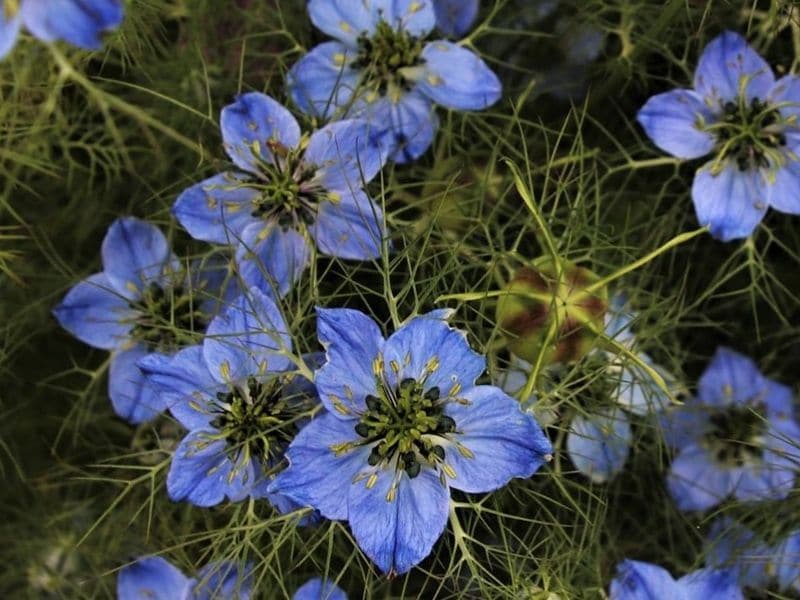
The Love in the Mist plant or Nigella is a plant with very fine leaves similar to a feather. The foliage makes a fringe around the flowers and may act like a veil.
Because of its spiky seed pods that develop, the plant is also referred to as the devil in a bush. The flowers tend to be light blue, deep pink, or even purple.
Lunaria

The Honesty plant or money plant also goes by the name Lunaria. It is a biennial flower that produces circular seedheads that look like coins.
The plant can grow up to 3 feet tall, and it self-seeds readily, so you don’t have to do much work with it each year. Blossoms are purple or white.
Lupin

The Lupin plant comes in several varieties including annuals and perennials. The annuals tend to be smaller, using less space in your yard. They are hardy but need full sun to grow.
Both the seeds and the plants are toxic and should not be ingested. Spires of blooms are produced by both types.
M
Magnolia

The magnolia is considered by many to herald the arrival of spring. It is a shrub usually around 7 feet tall (but which can grow to over 15 feet tall) that features starry white flowers between March and April. The plant is also known as the star magnolia because of its flower shape.
Maltese Cross

The Maltese Cross or Jerusalem Cross is a red flower that tends to be easy to grow. In drought affected areas, it can be a great addition to the garden for its tolerance of drought.
Native to Russia and Serbia, this plant was brought to Europe during the Crusades. It has also been called the burning love flower.
Mandevilla
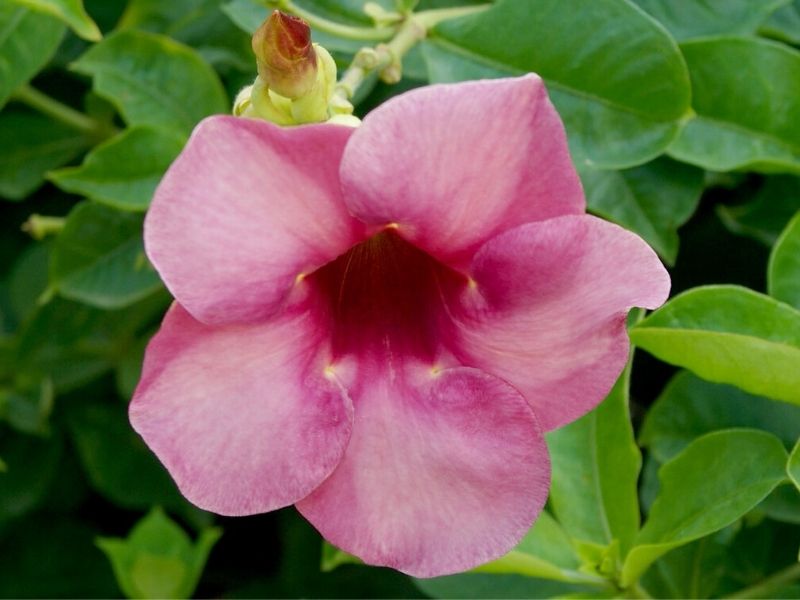
The Mandevilla or white dipladenia is a vine from Central and South America. The plant can reach a height of 10 feet and is a seasonal bloomer.
The white flowers have yellow throats, and the plant does well between getting full sun and partial shade. In places that get cold, it must be carefully overwintered.
Marguerite Daisy

The Marguerite Daisy is also known as Argyranthemum, and it is a perennial. Native to the Canary Islands, the plant is a seasonal bloomer.
Flowers can be yellow, pink, or white, and the plants need full sun to thrive. To overwinter the plant in cold climates, you should take cuttings as cultivars come from seed unreliably.
Marigold

Marigolds are hardy annuals that are simple to grow from seeds and that develop strong bloomers with varying tones of yellow and orange.
Marigolds are typically grown for cuttings, pots, borders, and as garden combination plants. These reliable bloomers create strong color with feathery fern like leaves. Marigolds offer the benefit of pest repelling through the presence of a specific odor.
Matthiola

The Matthiola or Brompton stock is a plant with flowers with a sweet scent. The flowers often rise above the foliage of the plant, and most are found in pastel colors, although some darker shades of purple and red can also be found. Grown as biennials, these plants need to be sheltered by have full sun to grow.
Mayflower

The Mayflower is a wildflower that blooms in spring. There are several plants that go by this name, including ones native to eastern North America and ones native to Europe.
Crataegus monogyna is a type of hawthorn and is most commonly referred to as the May flower or Mayflower plant.
Meconopsis
The Meconopsis or Himalayan blue poppy is a delicate poppy that produces a sky-blue flower recognized around the world.
These plants can be made to become a perennial if you prevent the plant from blooming when it first sets buds. The plant is typically only a couple feet tall in gardens but gets to be over 6 feet high in its native China.
Mimosa

The Albizia julibrissin or silk tree is also commonly referred to as the Mimosa tree. This tree can reach heights of 40 feet and easily spread to 50 feet. It blooms between June and July with delicate pink blooms.
The tree does well with full sun but can tolerate partial shade. The tree thrives in the heat of the summer and doesn’t do well with cold climates.
Moonflower Vine
The Moonflower Vine is a species belonging to the genus Ipomoea like the Spanish flag vine. This flowering vine can grow to heights of 15 feet, and the vine produces white flowers between July and October. It needs full sun but otherwise requires minimal maintenance, making it a showy member of your garden family.
Monk’s Hood

Monk’s Hood or Monkshood plant belongs to the genus Aconitum. It is a perennial with a tuberous root that blooms deep purplish-blue color between the months of July and August.
It will tolerate areas in the garden between full sun and partial shade but requires well-drained soil to grow best.
Moraea
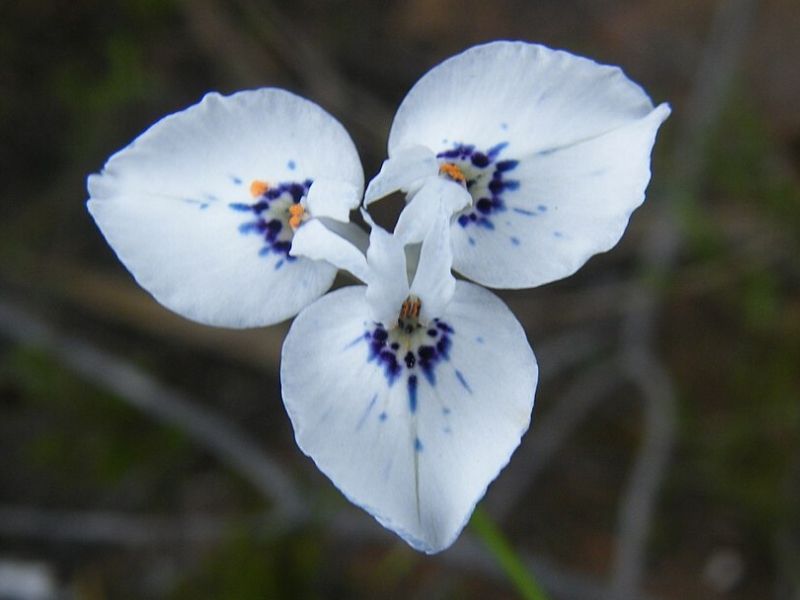
The Moraea is more commonly known by its nickname as the butterfly or peacock iris. This plant comes from Africa, and to grow them, you often need to find a bulb specialist who has them. The flowers produce three showy petals on the outside and three on the inside that are much smaller.
Morning Glory

Morning Glory is a vine that grows in moist but well-drained soils. Another member of the Ipomoea genus, it can grow 10 feet tall.
The vine is natively from Mexico but is now grown around the world. The flowers that bloom are a purple with a white throat between June and October, attracting hummingbirds and butterflies.
Moss Rose
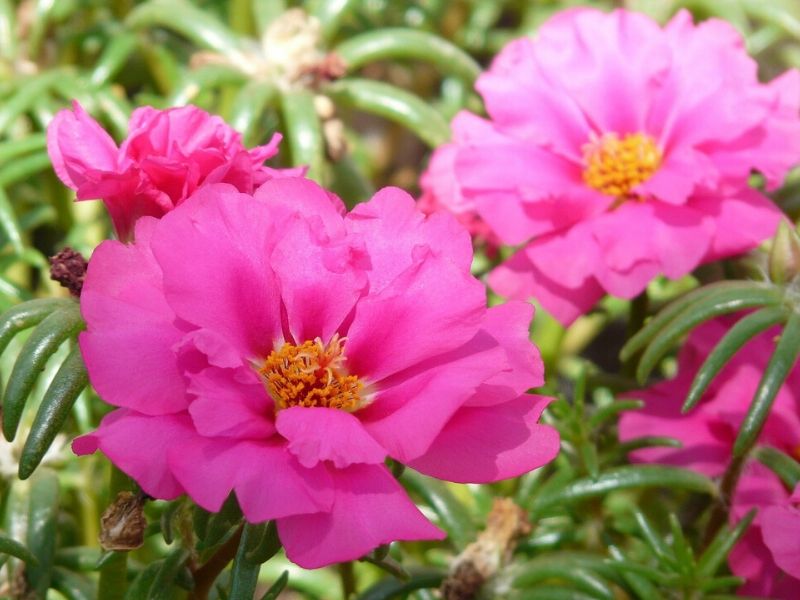
The Moss Rose, or Portulaca grandiflora, is an annual native to areas of South America, such as Brazil. It is a small plant, only growing about three-quarters of a foot tall, but it produces blooms between June and the first frost. The flower produces blooms in a range of colors, including rose, orange, and white.
N
Narcissus
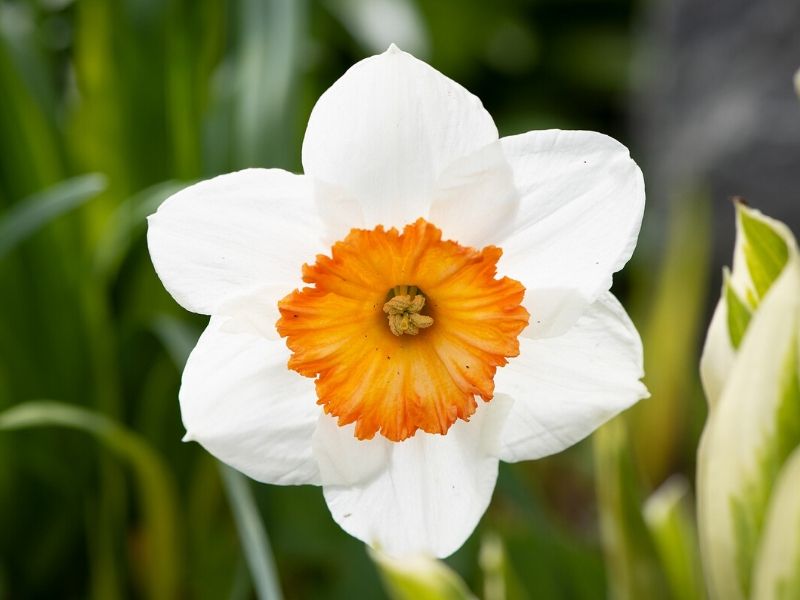
Narcissus is made up of many species and cultivars of flowers, with the most commonly known as the Daffodil. While yellow is the most common color, they occur in other colors, including pink and cream.
You can find dwarf or taller varieties, so there are plenty of different bulbs to find the right plant for your garden.
Nasturtium

Nasturtiums are also known as Tropaeolums. These annuals are prolific, easy to grow bloomers that are known for their beauty, health benefits, and nutritious properties.
Both the flower and the leaves are edible and reportedly have a “peppery” appeal. Nasturtiums flowers in solid colors such as red, orange, and yellow, as well as variegated “jewel-toned” beauties with rich, round leaves.
Nemesia

The Nemesia plant is excellent for container gardens, as all varieties only grow to about a foot tall or less.
These annuals produce flowers in a range of colors, including bright oranges and pinks, and they may be single colors or a mixture of colors. They tend to be easy to grow, making them great plants for beginning or master gardeners alike.
Nemophila

Nemophila is also referred to as baby blue eyes. An annual, it can be sown in fall or spring. The flowers may be white, sky blue, or black and white and only grow up to 8 inches high.
These plants tend to spread and make a carpet, and they produce a feathery foliage. They like full sun and well-drained soil.
Neoregelia

The Neoregelia plants are also known as blushing bromeliads or the heart of flame. The size of these plants is varied, with some growing to only 2 inches wide, while others may spread to more than 3 feet. These plants are often hybridized, which has produced a bounty of different cultivars.
Nerine
The Nerine plant or Guernsey lily produces colorful plants just in time for your fall garden. The flowers produced are bright pink, red, white, or even apricot and develop before the leaves of the plant appear. They grow from bulbs and do well in gardens left undisturbed or in container gardens.
New Zealand Tea Tree
The New Zealand Tea Tree is an evergreen plant known by the scientific name, Leptospermum scoparium. The blooms appear without a stalk and are roughly disc-like.
The leaves are small and narrow. The plants can be difficult to care for and only short-lived, but they are beautiful, with blooms of red, pink, and white.
Nierembergia

Nierembergia is also known as the cupflower. This plant is an herbaceous perennial that is native to Central South America.
It is relatively small, only growing to around 1 foot tall and wide. It blooms between May and the first frost, and the blossoms may be a light blue to a violet blue.
Nolana

The Nolana or Chilean bellflower is a member of the nightshade family (rather than the morning glory family, which they resemble).
A desert plant that thrives on the heat of summer, this plant produces bright blue flowers. The flowers are trumpet-shaped and do well in containers such as hanging baskets.
O
Oleander

The evergreen Oleander plant is sensitive to frost, so it must be carefully overwintered. This shrub may be 4 to 6 feet tall, and it produces flowers that may be white, yellow, apricot, pink or scarlet, and single or double blooms may develop on this plant between the months of June and November.
Olearia
The Olearia plant hails from New Zealand, and it is a bushy, flowering shrub. During the spring, it produces small green leaves, but its flowers bloom during the summer and are white, starry-shaped flowers.
The scent is similar to that of the hawthorn family of plants, and the plant gets to be at least 4 feet tall.
Orchid

Orchids are a delicate flower with species found around the world. These plants come in colors across the spectrum, from red to white, but they can be very difficult to grow.
They are very sensitive to over-watering, which may cause the roots to rot and lead to the plant dying. They must also be regularly fed to keep these lovely plants alive.
Oriental Lily
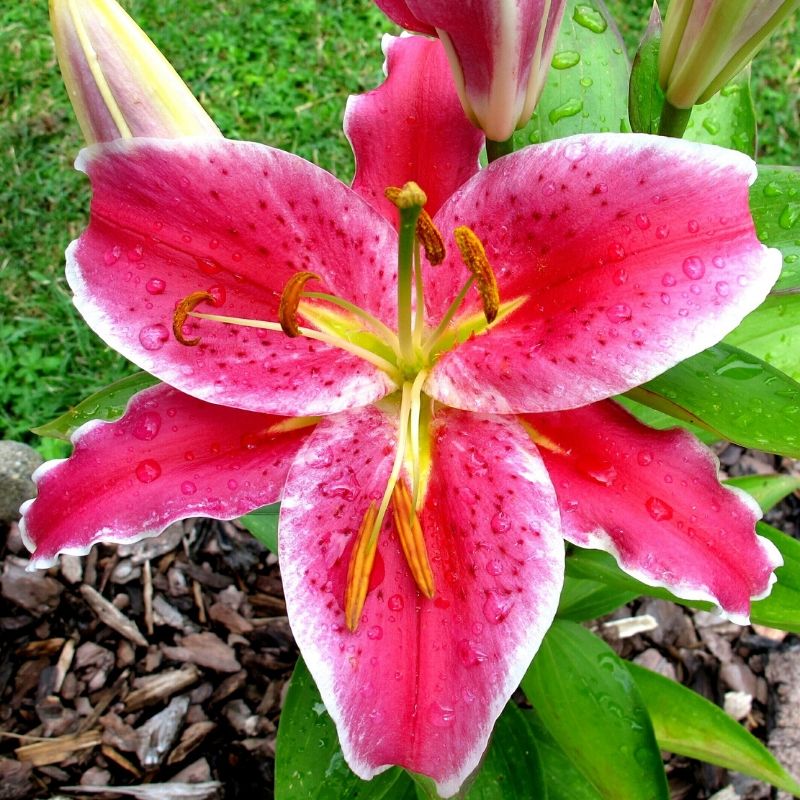
The Oriental Lily belongs to the Liliaceae family of lilies. They bloom between July and August, and the plants have a characteristic appearance. They are white with pink spots on the petals.
These flowers make good cut flowers and are fragrant, so make a great addition to potted plants right outside your door.
Oriental Poppy

The Oriental Poppy is a member of the Papavaraceae family. There are several varieties, such as the Allegro variety, which is red orange in color.
The plants need full sun and bloom between June and July. These plants favor colder weather and don’t do well in hot climates, preferring instead to have a period of winter dormancy.
Ornamental Cherry

The Ornamental Cherry may be a deciduous or evergreen tree or shrub, reaching heights of 14 feet tall, depending on the variety.
A member of the Prunus genus, the flowers may appear in shades of pink, red, or white. The flowers may be single or double, and there are dwarf varieties that do well in small gardens.
Ornithogalum

The Star of Bethlehem or Ornithogalum plant belongs to a group of around 100 species of plants that are native to Africa, Europe, and Asia.
The most popular species is Ornithogalum thyrsoides, or the chincherinchee plant. It produces spikes of white summer flowers, the most common color for these plants to blossom with.
Osteospermum

The Osteospermum (also known as daisy bushes or African daisies) may be grown from seed or purchased as a young plant.
While cold weather climates require that the plants be overwintered, milder areas may see the plant produce blooms throughout the winter season. This plant is often found as a white flower, and it requires full sun to grow.
Oxalis

The Oxalis or wood sorrel plant is a plant that can become very invasive so should be grown carefully. It produces clover-like leaves with satiny flowers that have 5 petals.
The plant comes in colors such as purple or yellow, but it is most commonly found as a white or pink plant, only growing up to 8 inches high.
Oxeye Daisy

The Ox Eye Daisy belongs to the genus Heliopsis. These perennial plants bloom between July and the first frost, giving gardeners plenty of opportunity to enjoy the blooms.
The flowers are yellow and require full sun for best results. They are good cut flowers and attract pollinators such as butterflies.
Oyster Plant
The Oyster Plant is known by several names, including Moses in a basket, boat lily or Tradescantia spathacea.
This perennial plant is native to areas of southern North America and Central America, including Mexico and Belize. They are a seasonal bloomer, and these plants produce a white bloom with a bluish blush.
P
Painted Daisy

The Painted Daisy is also known as Tanacetum coccineum, a perennial from the Caucasus Mountains in Asia.
The flowers bloom between June and July, and the flowers are white, pink, or red blossoms with yellow central areas. They make good cut flowers, and they can tolerate full sun to partial shade.
Pansy

Pansies are popular cool weather flowers that do well in spring and fall. The flowers are often multicolored with “faces,” that can be yellow, purple, blue, and red.
These colorful flowers like soil that is loamy and can do well between full sun and partial shade. They attract pollinators such as butterflies.
Parodia

The Parodia or ball cactus is a type of succulent. These are native to South America, including Brazil and Argentina.
These cacti flower profusely and are typically rounded, although you may find some that are column-shaped.
The cactus plants have varying amounts of spines, with some being covered and others having them sparsely.
Passion Flower

The Passion Flower or Passionflower is a vine that is native to the eastern United States. These flowers bloom between June and September, with different species being different colors.
For example, the Passiflora incarnata, is white with a purple crown. They are edible flowers and attract pollinators like butterflies.
Peace Lily

The Peace Lily is a group of flowers that are perennials belonging to the family Araceae. It flowers freely, and the blossoms are white.
It is a shade loving plant, with partial to full shade. The leaves are evergreen, and the plant tolerates heavy shade. The soil needs to be kept moist but not soggy.
Pelargonium

The Pelargonium or bedding geranium are often raised from seeds. They have large and bright flowers, with some having ivy-like leaves.
The flowers may be a single color or mixtures, and more recently popular are the “rippled” varieties that tend to be showy and eye-catching. These are all half-hardy annuals.
Penstemon

The Penstemon plants are also known as beard tongue plants. They are a group of perennials with funnel or tubular shaped flowers.
Some flowers are multi-colored, with a base color and contrasting throat; the most common colors are red, pink, purple, white, and blue. They flower between summer and the middle of fall.
Peony

The Peony or Paeonia is a lovely and fragrant flower. There are less than 40 species found in the wild but hundreds of cultivars exist.
The flowers come in a range of shades of pink, purple, and white, and some flowers have crimped or fringed edges to the bright petals. The flowers may be single or double and they are commonly used in wedding bouquets.
Periwinkle
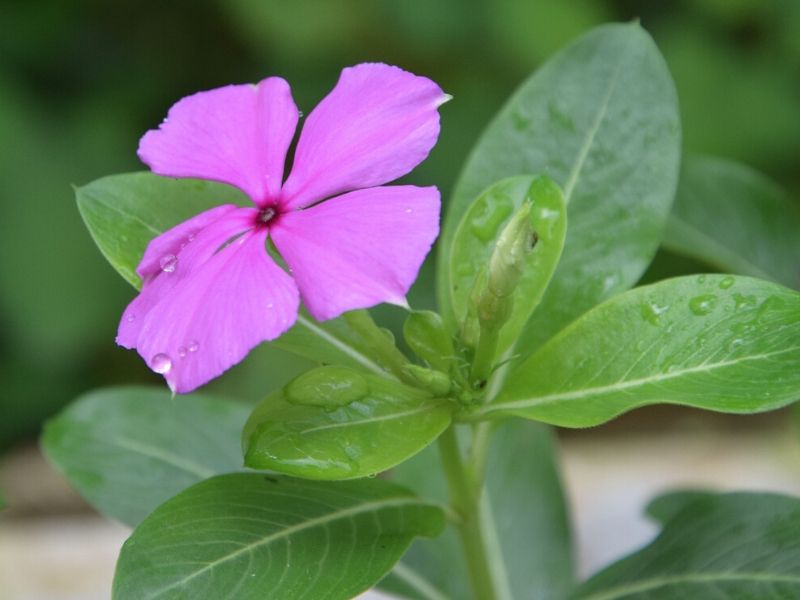
The Periwinkle is also by its scientific name as Vinca minor. It is a perennial that has a native range that extends from Europe to southern Russia.
They bloom between May and June, and the blooms are periwinkle blue in color. They do well in full sun to partial shade. They tolerate a great deal of conditions, including drought, erosion, and heavy shade.
Persian Buttercup
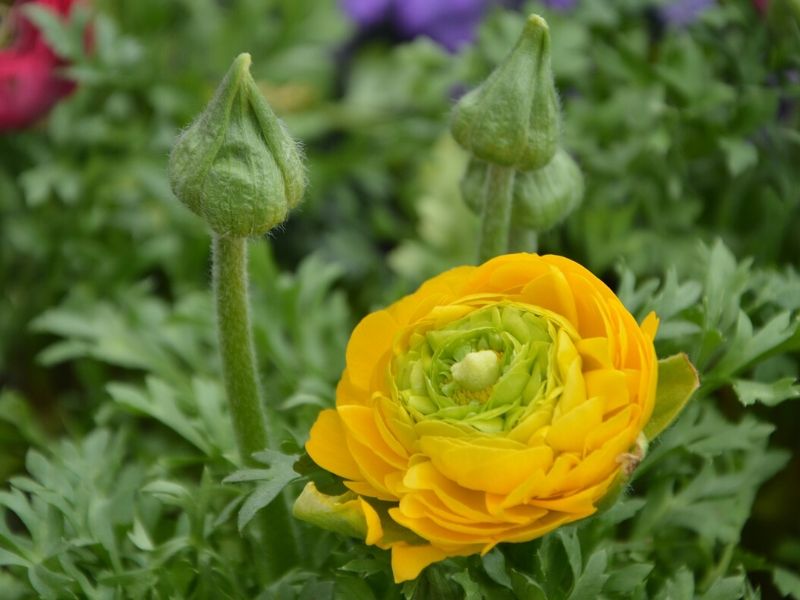
The Persian Buttercup is a member of the Ranunculus genus. It grows from a bulb, and it can natively be found in Africa, Asia, and Europe.
They bloom between May and June, and the flowers may be red, purple, white, and yellow, in different shades. They need full sun to grow well.
Petunia
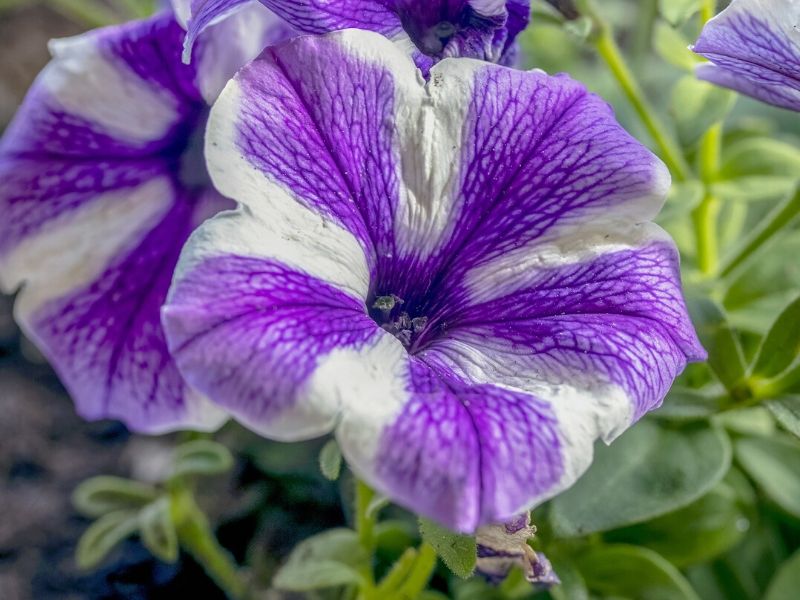
The Petunia is a classic and always popular flower. These come in a range of different types, with some being raised from seed, while others may be bought as already growing plants.
They come in a range of sizes, with colors also ranging between single shades, picotee, and striped varieties, to name a few.
Phlox

The Phlox plant comes in several varieties, including a creeping, alpine, perennial, and annual form. These plants can grow in a variety of settings, including containers or beds, and they also make great cut flowers. Some of the plants have a distinctive and flowery scent, and they range in colors from blue to pink.
Photinia

The Photinia has dense foliage and is a popular plant for hedging. The leaves are dark green and leathery, while new growth tends to be pink-red.
The flowers appear during the spring or summer, depending on the species, and the flowers are clusters of white blossoms, which don’t make good cut flowers.
Physostegia

The Physostegia virginiana is also known as the obedient plant and is a fast-growing perennial. These spread by runners and seeds, so take care that they don’t overtake the garden.
Flowers are usually pink, with cultivars being pink, red, or white. They bloom between summer and fall and look best planted in large clumps.
Pincushion Flower

The Pincushion Flower or member of the Scabiosa genus, which is an herbaceous perennial. These flowers have an extended bloom period, from April to the time of the first frost.
The species have different colors, and the Butterfly Blue species is lavender blue in color. They need full sun to develop well.
Pinks

The Dianthus or Pinks flowers are often referred to by other names, such as the Dianthus caryophyllus being called the clove carnations.
These have been used to scent cosmetic products for centuries, and fresh petals can also be put into salads and savory dishes. The flowers tend to be pink or white.
Poinsettia

The Poinsettia plant is a common flower used to decorate homes at Christmas. They are deciduous shrubs that can grow to a height of 10 feet, although they are commonly grown in plants.
A seasonal bloomer, they may appear in red, yellow, and white flowers. To grow, they need partial shade.
Potentilla

Potentilla are also known as cinquefoil plants, and they may be annuals, perennials, or even shrubs. The leaves have a classic shape, with five lobes, and the flowers may be yellow, red, or pink.
A relative of the rose, these plants have lovely foliage, and the flowers bloom between spring and summer.
Polyanthus

The Primula or Polyanthus plants do well in container gardens or flower beds. The Polyanthus is a hybrid primula, but each has brightly colors flowers that may be red, yellow, or cream, to name a few.
It is a hardy perennial, and the plants typically bloom throughout the spring, although some will bloom during the winter.
Poppy

The Poppy is a common plant that belongs to the genus Papaver. They bloom during cooler weather and are often found in cooler weather climes.
They bloom in a variety of colors, including bright red, yellow, and pink. They have single and double blooms that are often used to symbolize death and rebirth.
Powder Puff

The Powder Puff is a broadleaf evergreen tree. There are different species of Powder Puff, and they are native to Bolivia. They are a small tree, usually getting to around 3 to 6 feet.
The blooms are different colors, such as red. They need to have full sun to grow well, and they require high humidity and medium amounts of maintenance.
Quaker Ladies

The Quaker Ladies flower (also known by its scientific name houstonia caerulea) is a perennial wildflower. These are small flowers that are around 3 to 6 inches tall. The lobes of the petals are a pale blue in color, with some flowers being white in color.
These flowers prefer full or partial sun, and they like acidic soil. They grow best during the spring and can grow well in rock gardens.
Queen Anne’s Lace

Queen Anne’s Lace is a member of the carrot family, and it is a wildflower and herb. This plant is native to North America and features a flower that looks similar to the poisonous plant known as hemlock. In addition to growing in many places, these flowers make excellent dried flowers.
Queen of the Meadow

The Queen of the Meadow is also referred to as meadowsweet, and these plants are considered a noxious weed in certain areas of the United States, so plant them with caution. They are a perennial natively from Europe and Asia that produces white to yellowish flowers between June and August.
Queen’s Cup
The Queen’s Cup is a wildflower found natively in the United States. It produces a white flower that sits atop a slender stalk. It’s often known as Bride’s bonnet and its scientific name is Clintonia uniflora.
The leaves of the plant are lance-shaped. During the summer, a blue berry is produced. Take heed though, while the ruffed grouse eats this berry, it is toxic to humans.
Quince

Quince is a tree or shrub that produces a fruit. These plants are from Western Asian and flower between April and May, producing pale pink to white blossoms.
The plant tolerates full sun to partial shade, and it prefers fertile, well-drained soils with medium moisture content. The fruits are best picked after a long, hot summer.
R
Rain Lily

The Rain Lily, a member of the Zephyranthes genus, is a plant that grows from bulbs. It is natively from South America, such as Uruguay, and the plant blooms between August and September.
The plant produces flowers that are white, but you will find that some flowers are blushed with pink.
Rock Rose

The Rock Rose (or cistus) is from Europe and Asia Minor. This plant is an herbaceous perennial that grows up to 1 foot high and 3 feet wide.
The rockrose plant produces blossoms between May and June, and the blossoms are pale pink or yellow in color. They make excellent ground cover for your garden and tolerate drought conditions well.
Rondeletia
The Rondeletis is also known by its other name, the Panama rose. It is a large shrub or small tree, and it produces fragrant flower clusters that attract butterflies as they are full of nectar.
The flowers are pink, and they release the most fragrance during morning and evening hours.
Roses
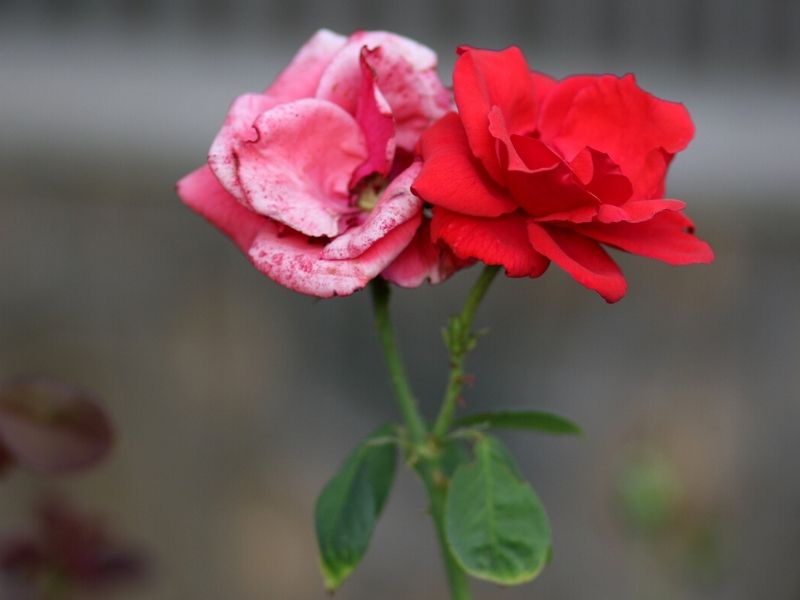
Out of many types of flowers, rose is probably the most popular flower name that everyone knows.
There are a variety of species of Roses, but all can produce showy flowers. The plants have flowers that bloom on a bush, and may occur in a variety of colors from pastel pinks to dark, deep blues.
Different species have different blooming times, between spring, summer, and fall. They prefer full sun for optimal growth.
Rose of Sharon
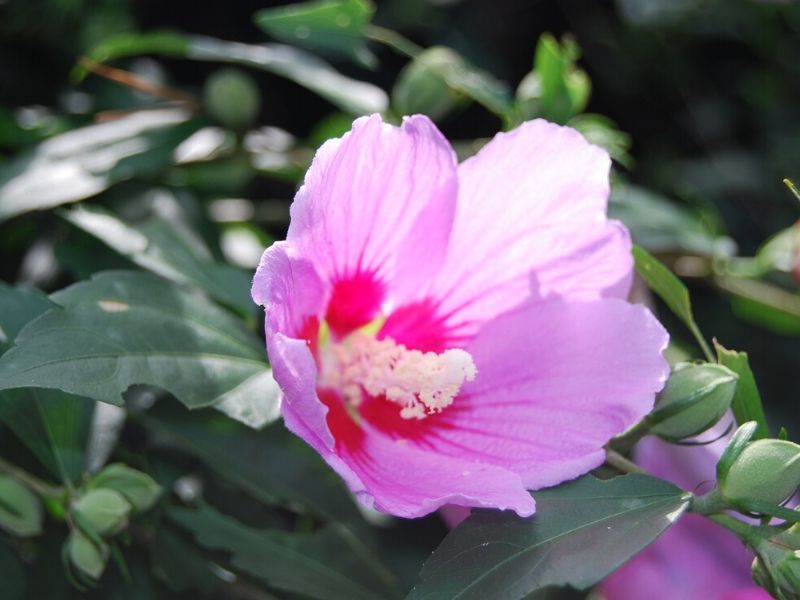
The Rose of Sharon is also known as Hibiscus syriacus. The plant produces blooms between June and October, and the blossoms are pink with red eyes.
Natively from China and Japan, these plants can grow to 12 feet high and need full sun to partial shade to thrive. They attract birds and butterflies to your garden.
S
Sage

Sage is both an herb and a perennial flowering plant. It is commonly used in culinary pursuits, where it may be used as a seasoning. The plant can also be used ornamentally, with blue blooms in June.
From the Mediterranean region, the leaves are gray green and fragrant, and they are the part typically used in cooking.
Saint John’s Wort

Saint John’s Wort is a perennial flowering herb, native to Europe and Asia. It grows into a deciduous shrub between 3 and 4 feet tall.
The herb has yellow flowers and grows wild. Saint John’s Wort goes by a variety of names including Goatweed, Hypericum, and God’s Wonder Plant. It attracts bees, birds, and butterflies.
Saint John’s Wort has been used for treating mental health issues such as depression, insomnia, and anxiety issues.
Scaevola
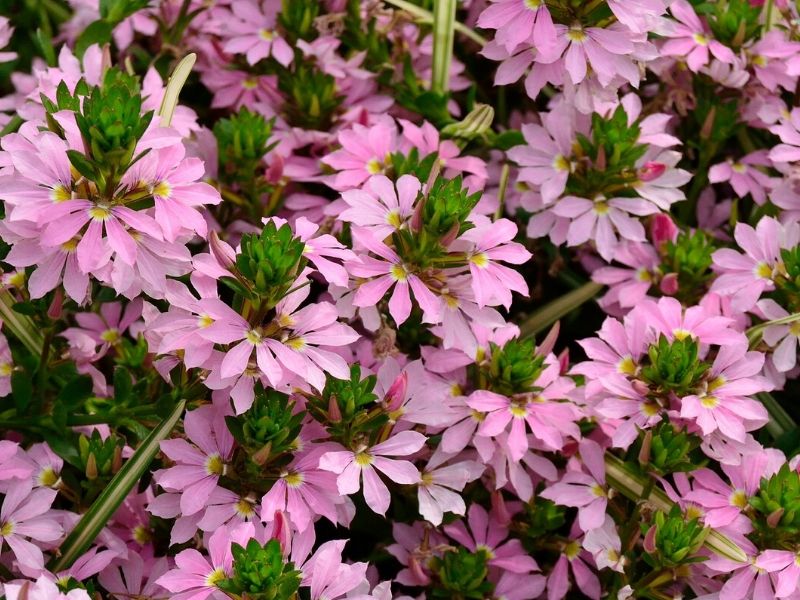
Scaevola also goes by the name of Fairy Fan Flower. The Fairy Fan Flower sports dainty blossoms in shades of pink, white, blue, and purple with foliage ranging from blue to green.
It is a popular flower bed and hanging plant due to vine-like growth. Scaevola is a native plant of Australia and is resistant to droughts and heat. The Fairy Fan Flower is also helpful in butterfly gardens.
Scented Geranium

Scented Geraniums are members of a group called Pelargonium that are known for accented or aromatic leaves.
Besides being ornamental in nature, the sweet-smelling foliage is evergreen and can be dried and used in sachets and potpourris. The plant flowers throughout summer with pleasing light pink 5-petaled blossoms.
Scilla
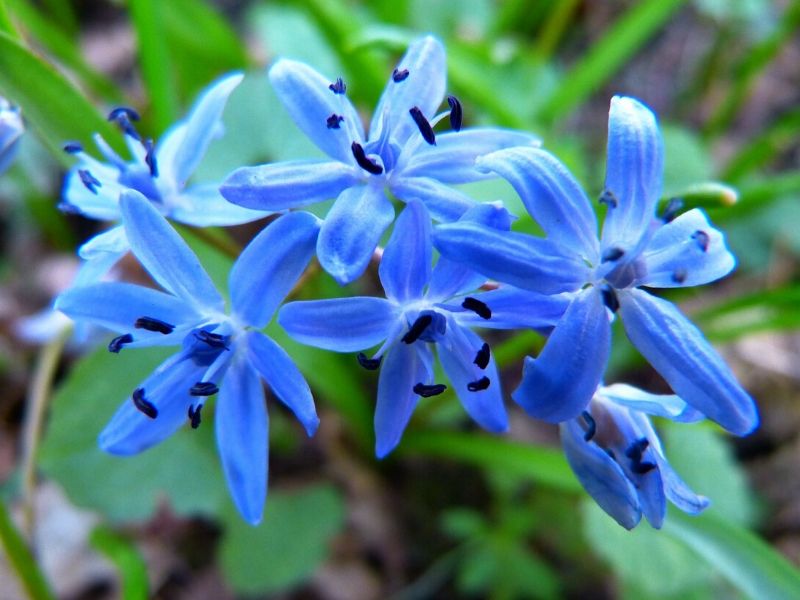
Scilla is a member of the Asparagaceae family originating in Eurasia, Africa, and the Middle-East. It is a perennial bulb plant, also called Siberian Squill.
In nature, Scilla is found from seashores to fields and forests. Blooming in the early days of April, on a 3 to 6 inch stem, appear green leaves and vivid blue bell flowers with matching anthers.
Sedum

Sedum, also known as stone crop or gold moss stonecrop, is a succulent perennial that thrives in full sun and requires little water.
It is a spreading evergreen ground cover with fleshy stems and thick leaves that overlap like roof tiles. Small star-looking 5 petal flowers bloom in clusters throughout the summer months.
Shasta Daisy
Species of Leucanthemum are commonly referred to as Shasta Daisies. These flowers can grow to heights as tall as 4 feet, and they bloom between July and September.
The blooms feature rays of white petals around a central yellow disc. They need full sun and make excellent cut flowers.
Silene

Silene is a perennial member of the Caryophyllaceae family, nicknamed campion or catchfly. It has sticky stems that explain the catchfly label.
Originating in Europe, it grows 12 to 16 inches with leaves ranging from gray to green. The flowers appear in late summer and range in shades of pink to purplish red-pink.
Snapdragon
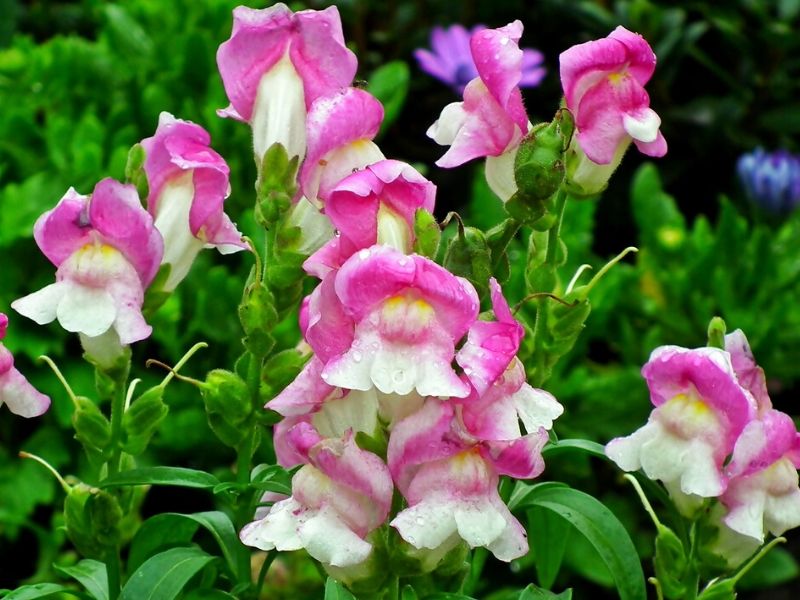
The Snapdragon is also known as antirrhinum, a plant that comes in three different groups depending on its size, and they need full sunlight.
There is a wide selection of colors, from solid colors to bicolor to doubles. The name comes from plants of older varieties opening when they were squeezed at the sides.
Snowdrop

Snowdrops or Galanthus are perennial bulb plants that stem from one of about twenty species of the Amaryllis family.
Native to woodlands in Eurasia, they are harbingers of spring, often sprouting through frost covered ground. The plants have two elongated simple leaves and just one tiny white bell-shaped flower with green markings on the interior of the blossom.
Snowflake

Snowflakes are bulbous perennials and part of the Leucojun family. These plants are native to Europe. Blooms appear in mid-spring and droop from tall stems.
The snow-colored flowers from a delicate bell-shape in clusters of 4 to 8. These are hardy plants and have been favored as “pass-alongs” for generations.
Soapwort
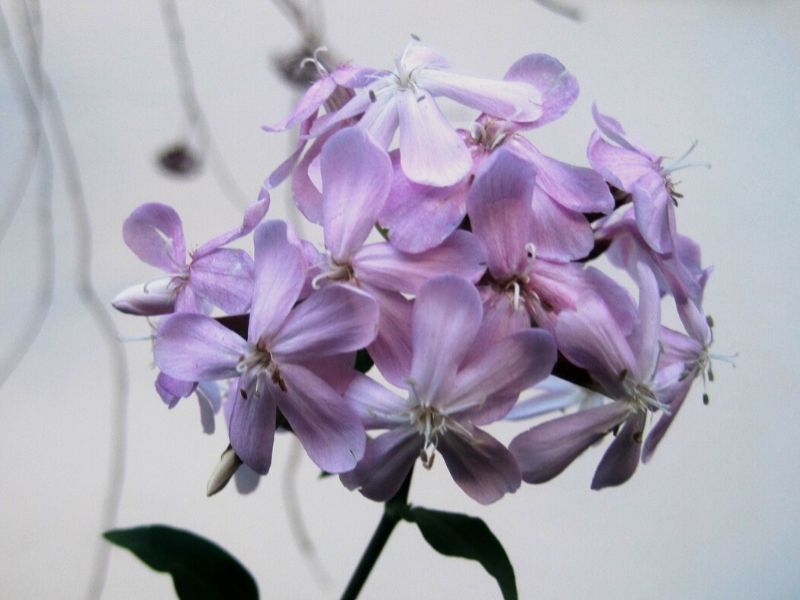
Soapwort is a perennial member of the carnation family and is also called Wild Sweet William, soap weed, bouncing-bet, and crow soap.
Native to Europe, soapwort can be seen in summer growing along roadsides. As a cultivated plant, soapwort grows approximately 1 to 2 inches tall with blooms ranging in shades from white to rose pink.
Speedwell

Speedwell, also called bird’s eye or gypsy weed, is a hardy perennial native to Europe. Speedwell grows in a variety of heights ranging from 4 to 18 inches. The plant has is slightly scented and spreads quickly.
Speedwell flowers are found in shades of pink, purple, blue, and white. The plant is known for “Old World” charm.
Starflower
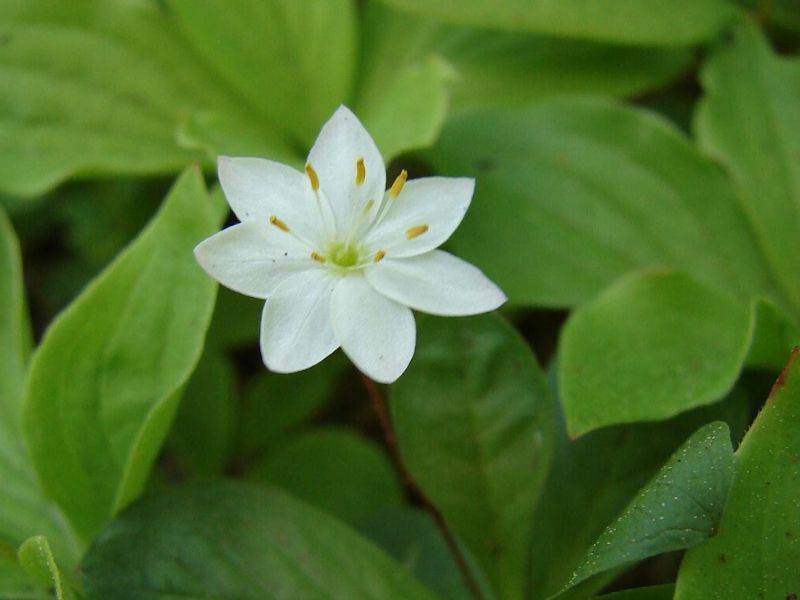
Starflowers (also known as Trientalis borealis or Lysimachia borealis) are perennials that grow from skinny rhizomes and are a part of the Primrose flower family. Starflowers are low-growing wildflowers native to North America. They are one of the most frequently found spring wildflowers.
They grow in wooden areas and fields, blooming in the cool temperatures of spring and early summer. Flowers are pure white stars made up of 7 tiny petals growing on short to no stems with a circular grouping of 5 to 9 leaves.
Statice

Statice is a member of the Limonium which contains at least 120 flowering species. The plant is also known as sea lavender, march-rosemary and caspia.
It is resistant to deer and grows best in sandy soil and full sun. Flowers are also lacy and come in light shades of purple, white and pink. Some Statice varieties have a foul odor.
Sunflower

Sunflowers are native to North and Central America and are part of the 70 species Aster family. They are grown as attractive cut flowers, with edible components for human and animals, and it is used to make yellow dye, lubricants, paints and oils. The fruit of the sunflower is an edible seed called achene.
Flowers grow resembling huge disc shapes on rough furry stems with layers spirals of course leaves. Blooms typically come in shades of yellow and brown. Smaller varieties form petal flowers and are mostly yellow in color.
Sweet Pea

The Sweet Pea plant is also known as Lathyrus. There are two major classes of this plant, there are dwarf varieties and tall climbing varieties.
The flowers come in a range of colors, such as pink, white, and blue. These annuals tend to be hardy and easy to grow, making them popular plants.
T
Tea Rose

Tea Roses are perennial shrubs that are known as the “modern garden rose”. They were developed by crossing rose varieties. They grow well in greenhouses and gardens.
Flowers bloom in a wide variety of colors and generally have a pleasing fragrance. Buds are uniform in formation, with a raised center. Stems are strong and straight.
Tiger Flower
The Tiger Flower is native to Chili and Mexico. It is a member of the Iris family, growing to approximately 2 feet with lance or sword-shaped leaves.
The Tiger Flower is also known as tiger iris, Mexican shellflower and peacock flower. Ancient Aztecs treasured the chestnut flavor produced by the plant. Flowers come in white, red, yellow, orange and pink with a spotted or variegated center.
Tithonia
Tithonia is native to Mexico, Central America and parts or the American Southwest. It produces 3 inch ornamental flowers in shades of red and resembles the dahlia. The leaves are heart-shaped and vibrant green. The stem is known for having a “swollen neck.” It is a hardy, drought resistant plant that blooms during the summer months.
Tobacco Plant
The Tobacco Plant is also known as Nicotiana. Rather than being grown for tobacco, these plants are grown for their beautiful blossoms. They produce tubular flowers, with dwarf varieties and larger plants reaching 5 feet. The flowers come in an array of colors, from pink to lime green and may release a pleasing scent.
Trachelium
Trachelium is a member of the Campanulaceae family. It requires a long growing season and produces more striking colors when grown in greenhouses. Seeds are so tiny that they require being pelleted in order to be visible. Flowers are tiny, feathery looking florets that come in shades from dark purple, pink, greenish white to blue.
Trillium
Trillium thrive in deep shade and produce flowers during both springtime and summer months. Blossoms sit at the center of rich green leaves and come in colors of yellow, burgundy, white, pink, reddish-purple and bronze-green. It is a perennial that grows from easy to divide rhizomes. Trillium spreads quickly as a delightful groundcover.
Triteleia
Triteleia is a bulb plant that originates in Western North America and is found primarily in California and Oregon. It is a member of the 15 species “cormous” perennial group. Ornate flowers bloom during the middle of summer on top of 18 to 24-inch bare stems. Colors range in shades of violet, blue and white and make super cut flowers.
Tritonia crocata
Tritonia crocata is a deciduous bulb plant from the Iridaceae family and native to South Africa. For proper growth, it needs full sun and soil that drains well. The plant does well in pots and gardens. Traditional varieties produce reddish to bright orange flowers, highlighted with a deepening colored throat. Leaves are short and appear like swords. The plant is a food source for honey bees.
Trollius
Trollius is an herbaceous perennial, also known as a globe flower. Part of the buttercup family, Trollius thrives in moist soil, such as found around lakes or ponds. Flowers are globe in shape and yellow in color. They sit on stems between 18 and 24 inches that are marked with few leaves. Established plants from clumps. They grow well in borders.
Trumpet Vine
The Trumpet Vine, nicknamed cow-itch or trumpet creeper, originated in the eastern United States. It is characterized by a quick-growing woody vine that can reach heights of 30 to 40 feet. Flowers are a bright orange or scarlet color and have an appealing trumpet shape. In the fall, thick pods resembling bean pods appear and are spread by the wind.
Tuberose
Tuberose grows from a bulb and is part of the asparagus family. It is a perennial and also known as a Polyanthus lily. Native to Mexico, the plant grows to heights of 4 inches characterized by vivid green leaves around the base and brilliant clusters of shiny white blossoms. Due to a pleasing strong fragrance, the flowers are also used in perfume, treasured as cut flowers and in borders.
Tulip

Tulips are hardy perennials that develop from bulbs best planted in the fall. With the arrival of spring, they are known as harbingers of the season and can create a dazzling display of color with single, parrot, bicolor, doubles, and even fringed blossoms.
By planting a combination of tulip varieties, they will provide a long lasting display in containers, borders, or gardens.
U
Urn Plant
The Urn Plant, also known as Silver Vase, originated in the rain forests of South American, and they are members of the bromeliad family. They are prized as exotic house plants. The plant is characterized by a rosette of dark green leaves with markings of white to silver that form a reservoir. The reservoir needs to stay filled with water. Flowers appear in shades of pink with lavender markings.
Ursinia
Ursinia is a member of the daisy family and is native to southern Africa. These annual plants are started from seeds, are easy growers, and do well as bedding plants. Flowering occurs beginning in July and continuing into September. Large daisy-type flowers bloom in shades of orange to yellow with the center of the flower having a distinct dark ring.
Uva Ursi
Uva Ursi is a hardy creeping ground cover that blooms during April and May. Flowers are tiny, concave in shape, and droop downward in small clusters. Berries that form from the flowers are green in summer and turn red in the fall. The berries are food for wildlife and edible by humans. Leaves from the plant are used for making medicine.
V
Valerian
In some places, Valerian is considered an invasive weed and is not allowed to be planted. Regardless, this “weed” has some important usages, with the roots being used for herbal medicine for centuries to treat issues such as anxiety. The plant’s flowers are white to pale pink, and the plant needs full sun.
Verbena
Verbena is a tuberous perennial that brings life to pots, flower gardens and borders, with vibrant colors including blue, purple, pink, blue, and red. Some of the varieties grown spread runners and flowers include attractive florets that give the garden different shades of colors as they mature. Once planted, they are known for establishing themselves quickly in the first season and are capable of blooming from spring until the fall.
Viburnum
There are many species of Viburnum. One example is the arrowhead viburnum or Blue Muffin plant, which produces white blooms between May and June. Native to North America, this plant can mature into a shrub that grows to around 10 feet tall. It tolerates full sun to partial shade to grow.
Viola
The Viola is a typical border or potted flower that can be an annual or a perennial. They come in two size varieties, pansies having the largest flower with violas sporting smaller blossoms. Violas come in single colors as well as bicolor and are highly valued as landscape and potted plants. Violas have the unique ability to withstand cold temperatures.
Virginia Creeper
Virginia Creeper is a vine plant that grows upward on surfaces or runs across the ground. It is characterized by leaflets containing 5 leaves with jagged or “toothed” edges. Tiny green flowers appear between June and August, followed by dark berries in shades of blue to black. Berries are food for wildlife. The bark, berries, and roots have been used in medicines.
W
Wallflower
Wallflowers are ancient perennial herbs that got their name growing in rocky cliffs or cracks in old walls. Varieties come in annuals, biennials, or perennials. Today wallflowers are grown for their ornamental beauty and simple charm. Their simple flowers contain 4 petals that bloom in bunches with colors ranging from yellow, golden brown, red, to brown.
Wandflower
Wandflower or Gaura originated in the southern United States as a perennial. Wandflowers bloom in late spring and are known for a long blooming season. These plants grown to heights of about 24 inches on stems covered with leaves that resemble fine hairs. The flowers are delicate and start out white, turning to pink.
Water lilies

Waterlilies are members of 58 species of plants found growing in freshwater habitats in temperate and tropical climates.
Water lilies are perennials and appear to float. In actuality, waterlilies are anchored on by fleshy stems buried deep in the mud of ponds or ornamental garden pools. The flowers appear solitary “cuplike” blossoms floating among green waxy leaves. They produce a berry or nutlike fruit.
Watsonia
The Watsonia plant is a flowering herbaceous perennial that stems from southern Africa. It belongs to the Iris family and is a bulbous plant. The Watsonia plant is characterized with “sword-like” foliage and trumpet flowers in tones of rose to pink mounted on tall slender spikes. Each plant blooms approximately 4 to 5 weeks and requires little tending.
Wax Plant
The Wax Plant or HOYA Carnosa is often found as an exotic houseplant, growing well in partial shade to sunny conditions. The Wax Plant has long, skinny vines that sprout stocky, green roughed leaves. The plant flowers from spring to summer in little clusters of cream to white or pink. Flowers are characterized with a star-shape and a fragrant smell.
Wedelia
Wedelia is a member of the sunflower family. Other names for Wedelia include Sphagneticolatrilobata, creeping daisy and rabbit’s paw. The plant is a perennial that develops a sturdy, mat-type ground cover. The green leaves are fuzzy, and the flower is golden and daisy-like. Wedelia flowers attract birds, butterflies, and bees. It is considered an invasive plant.
Weigela
Weigela is also known as Weigela florida. It is native to areas in Japan, Korea, and Northern China. Weigela is a deciduous shrub that typically branches in an arch formation towards the ground. Weigela is a heavy bloomer in springtime with attractive trumpet-shaped flowers in shades of rose to pink. The plant is slightly salt tolerant and attracts hummingbirds.
Whirling Butterflies
Whirling Butterflies, also called Gaura Lindheimeri, bloom from early spring until late summer. The plants grow on red stems resembling wands that grow up to 5 feet in height. Planting in groupings helps support these stems. Budding produces varying shades of pink. Flowers open as showy pure white 4-petaled flowers.
Winter Jasmine
Winter Jasmine is also known as Jasminum nudiflorum. It originated in China as a deciduous shrub, growing 10 to 15 feet. The plant has vine-like branches that trail to the ground and root. Winter Jasmine is resistant to droughts. The plant has green leaves and flowers in either black or tones of gold and yellow.
Winterberry
Winterberry is an excellent plant for bird gardens and natural gardens. It is a member of the holly family and originates in the eastern parts of North America. Winterberry holly is a dioecious plant which means that the species has a male and a female plant; necessary for pollination. Tiny white flowers during summer result in an array of brilliant red winter berries.
Wishbone Flower
The Wishbone Flower plants are also known as a summer pansy. Wishbone Flowers are annuals that grow well in shady to semi-sunny locations such as beds or flower garden borders. Plants range from 12 to 15 inches in size and produce colored blooms in shades of blue, white, pink, and blue to violet with highlights of yellow.
Woolly Violet
Woolly Violets are Viola sororia are short herbal perennial wildflowers that bloom early in the spring. Native to North America, Woolly Violets are often found near the edges of woods or fields and grow close to the ground with flat leaves. The flowers come in shades of medium to dark violet or blue to violet. The flower contains veins in darker shades of violet. There is also a white violet.
X
Xanthoceras sorbifolium
Xanthoceras sorbifolium is native to North China and a member of the sapindaceae family. Growing best in full sun, Xanthocerassorbifolium comes in a tree and a shrub version with sizes ranging from 8 to 25 feet. Also known as the yellowhorn, 1-inch star-shaped white flowers with centers sporting red or yellow accents bloom in May.
Xerophyllum
Xerophyllum is a member of the lily family and can be grown from rhizomes or seed. It is a perennial wildflower, blossoming with ornate white flowers beginning in springtime and ranging into summer. Other names include Indian-basket-grass, bear-grass, squaw-grass, and elk-grass which come from Natives using the leaf fibers for making baskets and clothing.
Xylobium
Xylobium, nicknamed Xyl, is a member of the Orchidaceae orchid family and has over 35 species. Flowers vary in color and formation depending on the variation. Xyl, originating in Central and South America tropical regions, has a woody type stem with 3 leaves and grows from an “elongated pseudobulb”.
Xylosma
Xylosma is part of the 100 species of Flacourtia family, native to the tropics. It is primarily used as topiary and hedge plants. It is a food source for caterpillars. The leaves are shiny and areas of new growth appear bronze in color while established leaves are yellowish-green. The blooms are yellow and delicate with a potent scent.
Y
Yarrow
Also known by the name Achillea, Yarrow is a perennial that produces largely while flowers from mid-late spring to late summer, although a range of shades have been produced, including crimson and apricot. These plants are easy to establish and long-lasting, and care must be taken to prevent them from overtaking the garden they are planted in.
Yellow Archangel
Yellow Archangel is a fast, low-growing perennial with semi-evergreen to evergreen tendencies. It is also known as Herman’s Pride, dummy nettle, and silver frost. The later name due to is variegated foliage. The flower is relativity small, a yellow bloom marked with 2 lips. The plant is used in ornamental baskets and pots.
Yellow Bell
Yellow Bells are low maintenance, easy to grow perennial flowering shrubs. Plants may grow as tall as 20 feet, with a circumference of 10 feet. Also known as Yellow Elder, yellow bells, and ginger-thomas, all belong to the Tecoma species. The plant produces beautiful trumpet-shaped clusters of brilliant yellow flowers that hang from the end of branches.
Yellow-eyed Grass
Yellow-eyed Grass is naturally found in areas along California’s northern coast. It is a perennial herb and member of the Iris family. Being only about 8 inches in height, it grows in clumps or clusters and spreads well. Butterflies and bees are attracted to the flowers which bloom during May and June.
Z
Zenobia
Zenobia is a semi-evergreen shrub that grows in the southeastern United States. Depending on conditions, the height of Zenobia ranges from 3 to 10 feet. It is also known as Dusty Zenobia or honey-cup. White bell-shaped flowers form during May and June; a slightly larger version of lily-of-the -valley flowers. Leaves are waxy and appear frosted.
Zinnia
Zinnias, also known as Mexican daisies, are grown from seeds and produce an abundance of striking flowers in the late dog-days of summer. Plants come in a variety of sizes and produce flowers from singles to doubles, to crested. Zinnias are treasured as cut flowers and as landscape plants. The adaptable Zinnia is also a must in any butterfly garden.
We have you enjoy our long list of flowers. Feel free to explore our blog for more specific flower plants and how to care for them.
References
Reference List:
The A-Z of Garden Flowers. Bay Books: 2005.
http://gardeningsolutions.ifas.ufl.edu/care/weeds-and-invasive-plants/wedelia.html
http://ipm.ucanr.edu/PMG/GARDEN/PLANTS/xylosma.html
http://pss.uvm.edu/pss123/annmarig.html
http://pza.sanbi.org/tritonia-crocata
http://pza.sanbi.org/watsonia-borbonica
http://www.anbg.gov.au/gnp/interns-2002/actinotus-helianthi.html
https://edis.ifas.ufl.edu/fp257
https://extension.umn.edu/flowers/daylilies
https://nccih.nih.gov/health/stjohnswort/sjw-and-depression.htm
https://plants.ces.ncsu.edu/plants/
https://plants.usda.gov/plantguide/pdf/pg_paqu2.pdf
https://pss.uvm.edu/ppp/articles/nasturtium.html
https://www.fs.fed.us/pnw/pubs/pnw_gtr864.pdf
https://www.fs.fed.us/wildflowers/plant-of-the-week/trientalis_borealis.shtml
https://www.fs.usda.gov/detail/ipnf/learning/?cid=fsm9_019077
https://www.fs.usda.gov/detail/ipnf/learning/?cid=fsm9_019077
https://www.nwcb.wa.gov/weeds/yellow-archangel
Close







